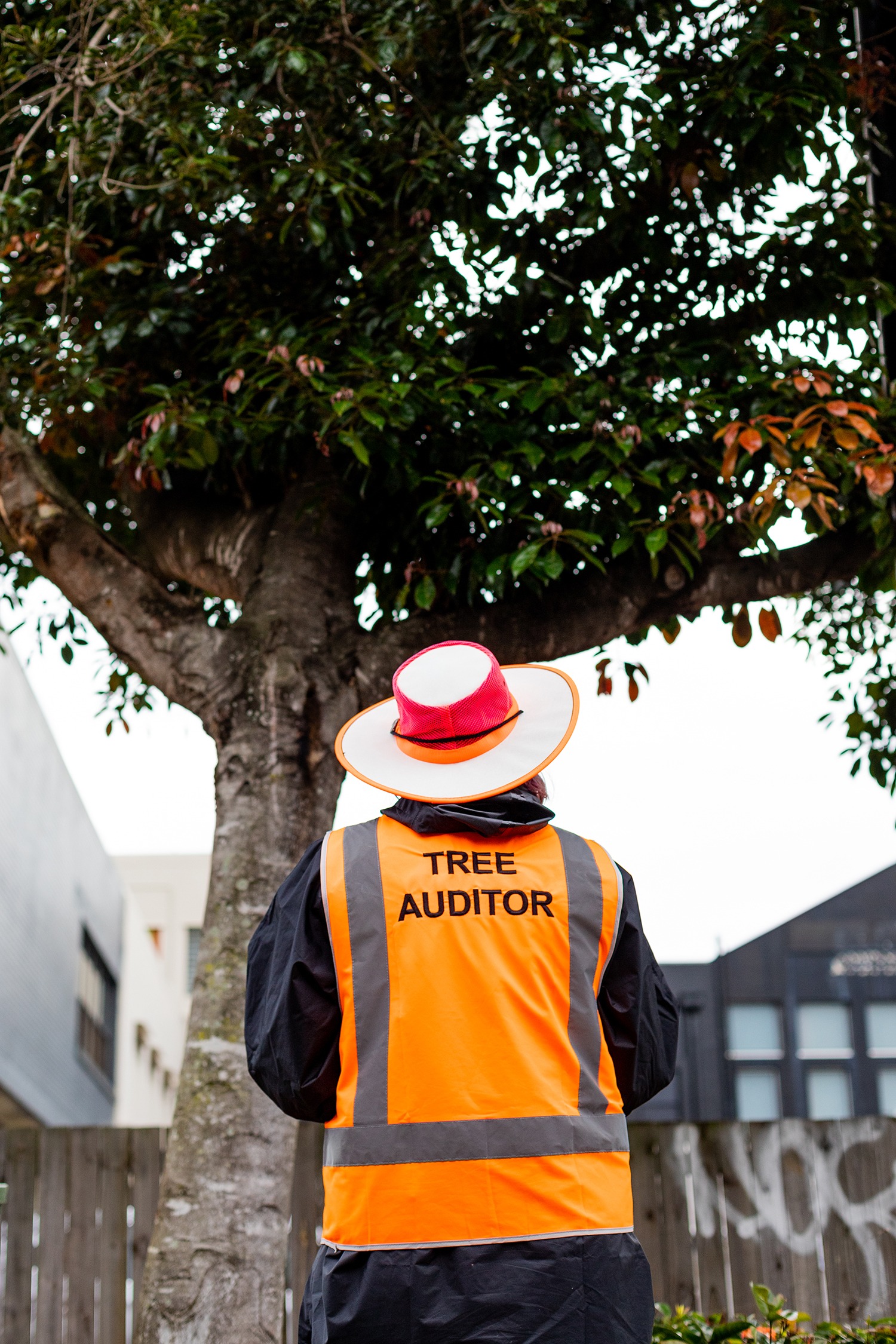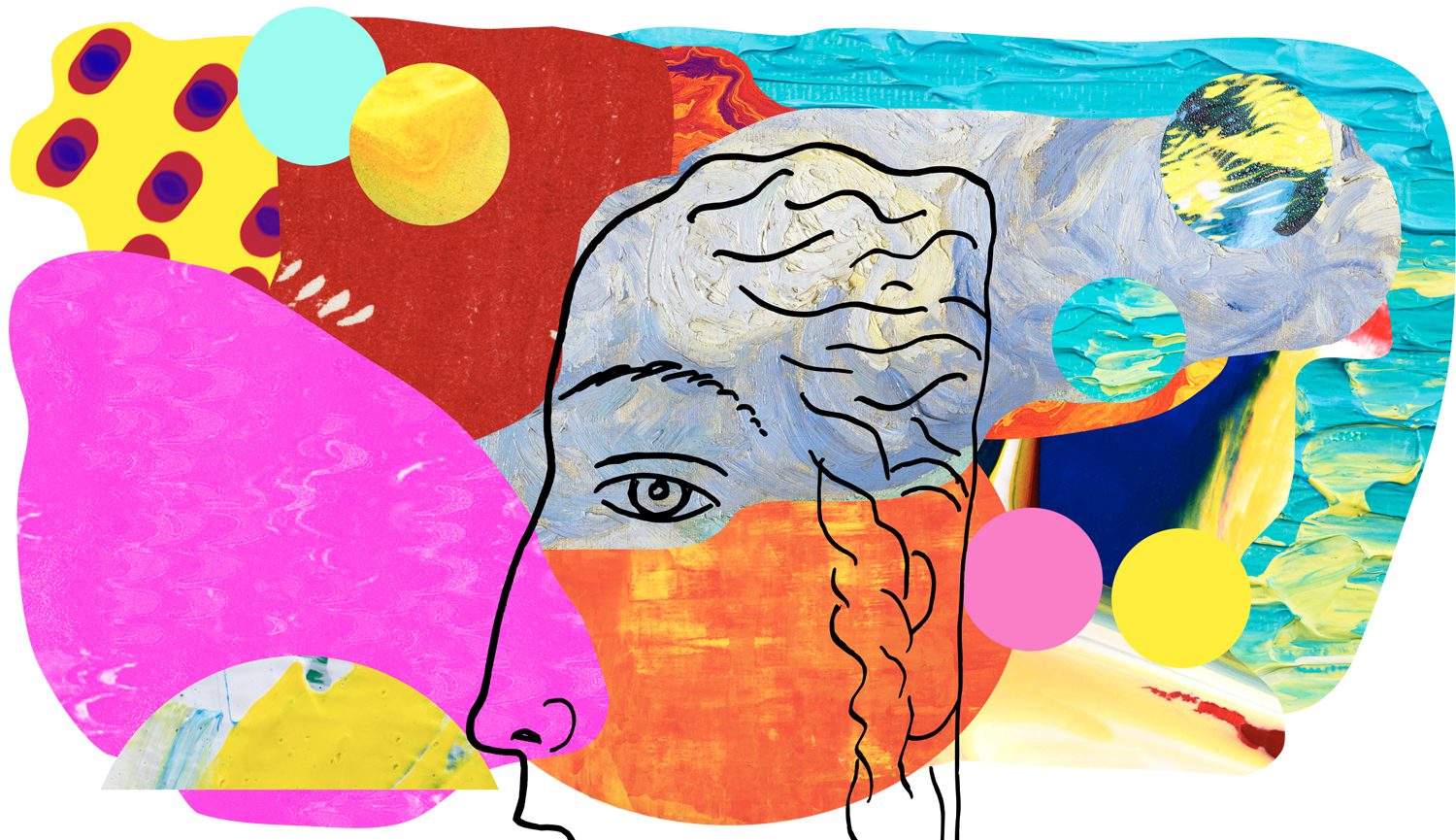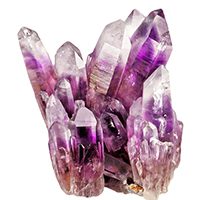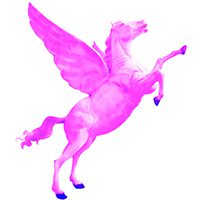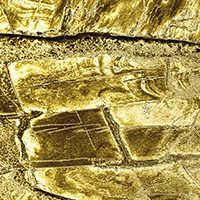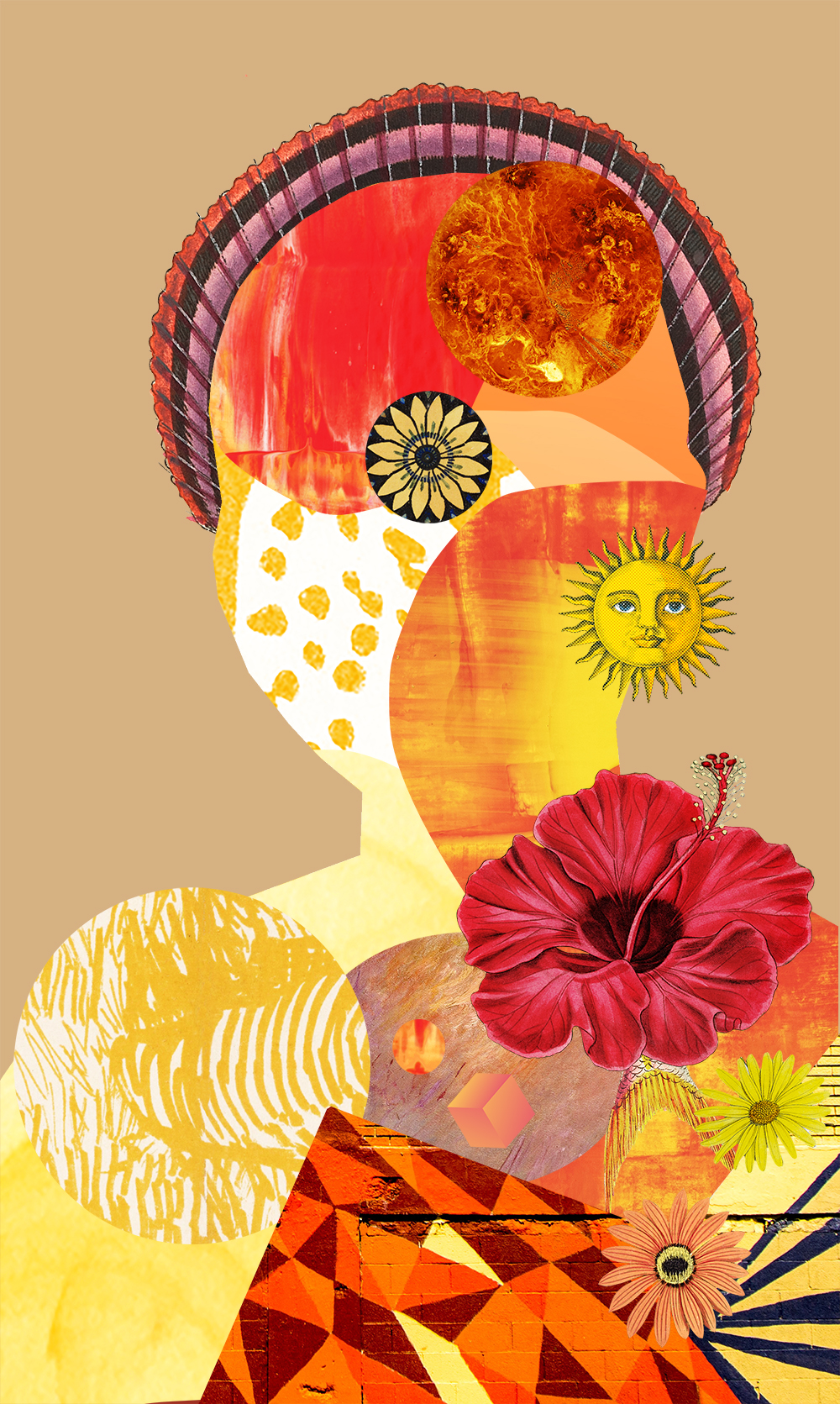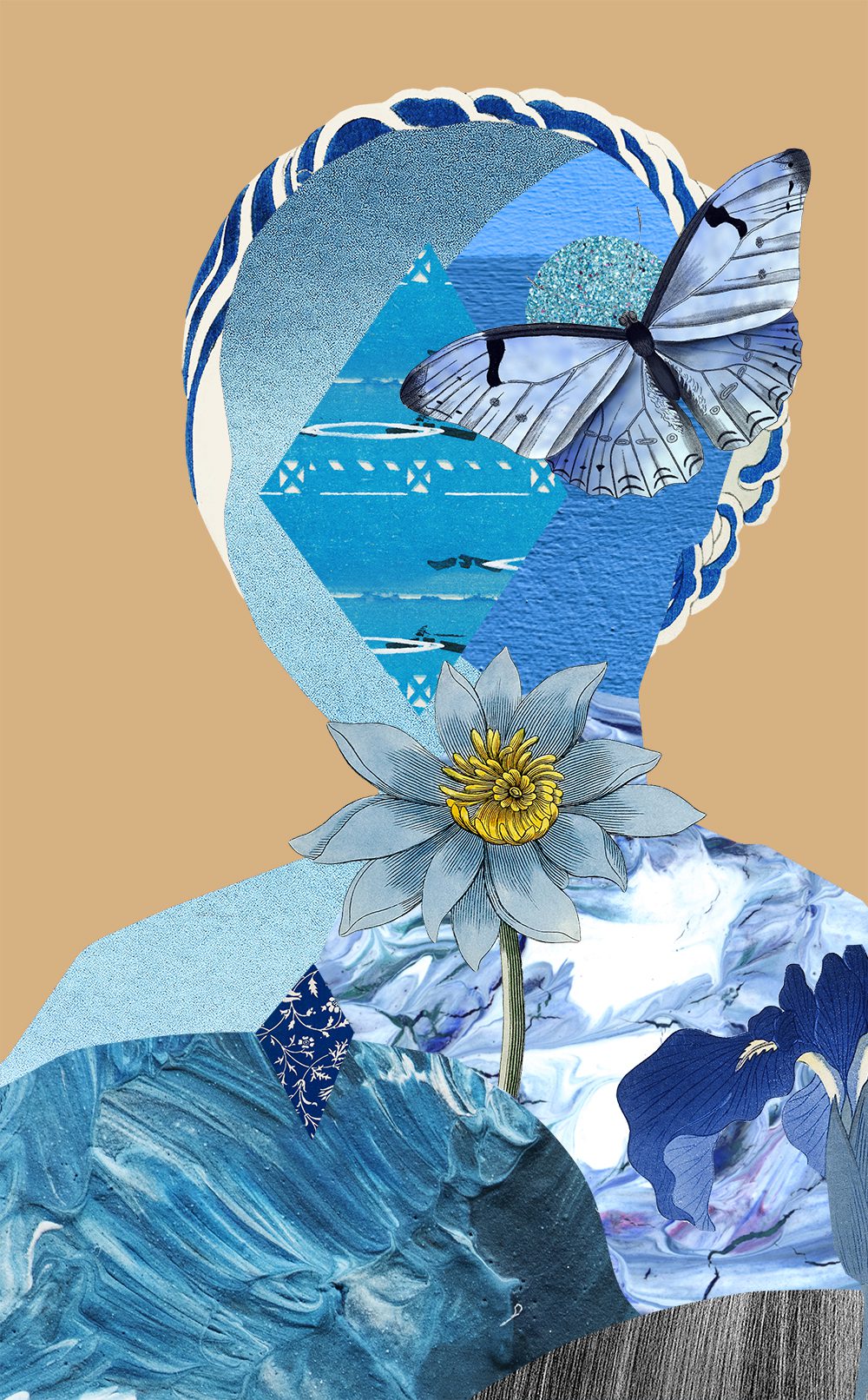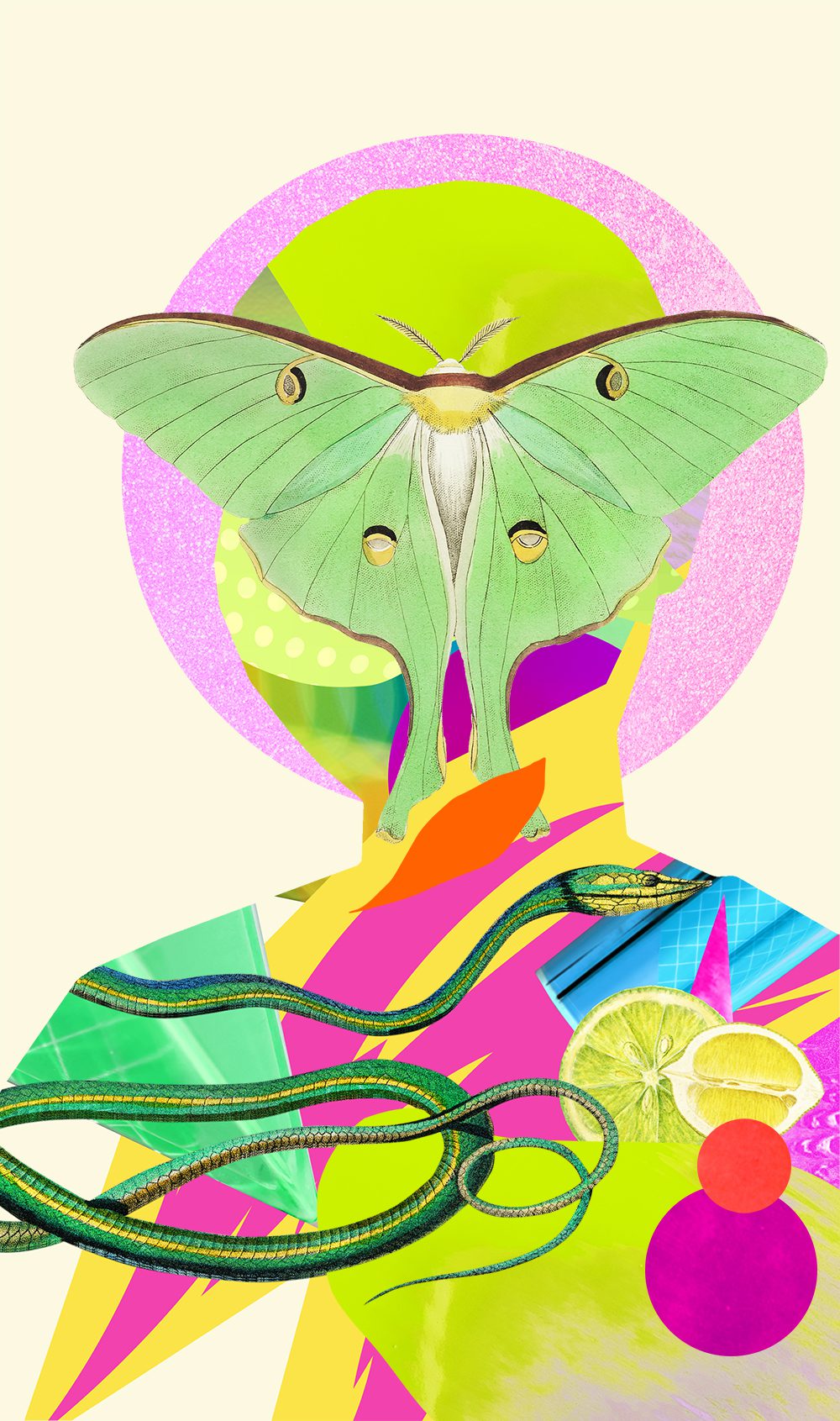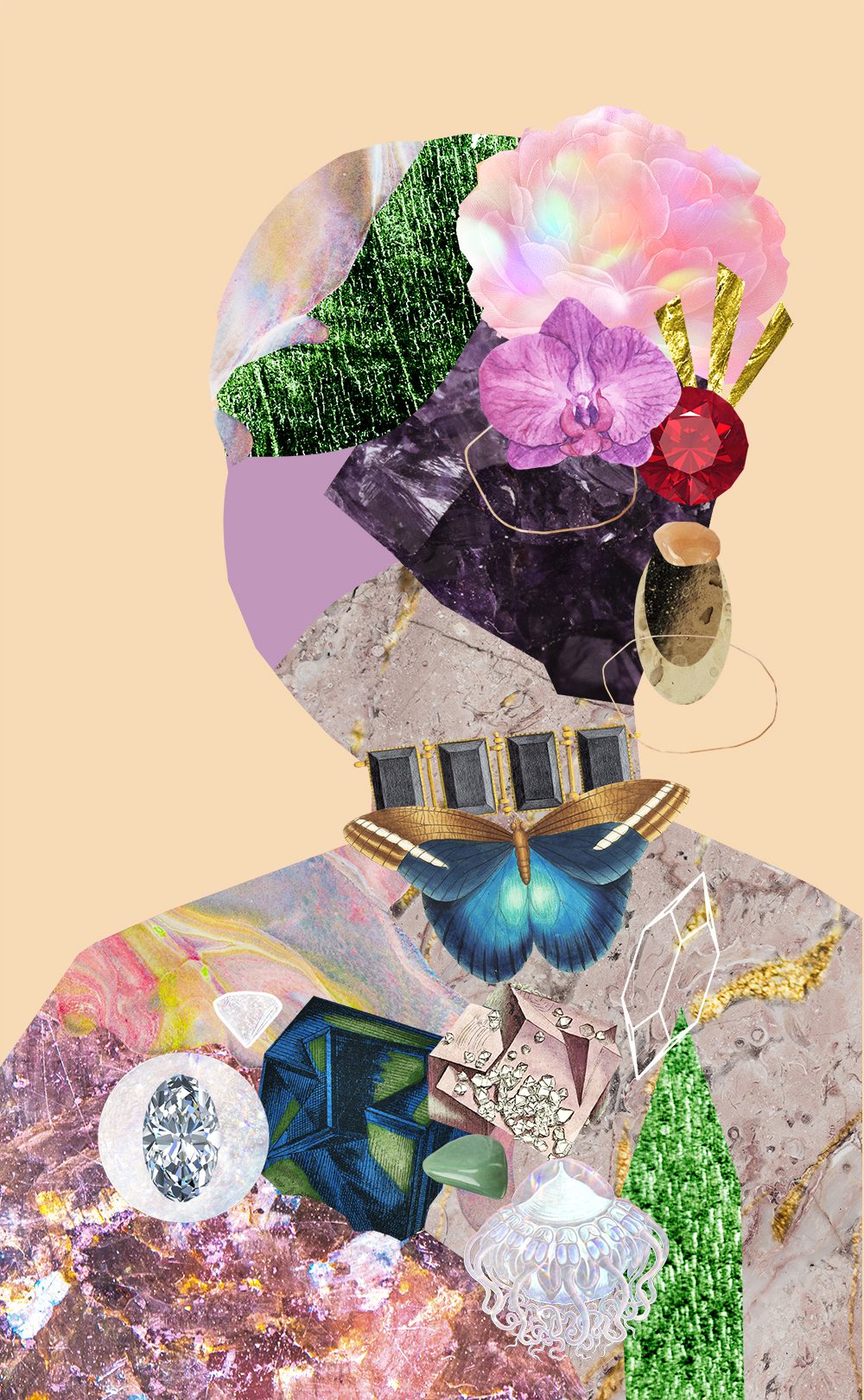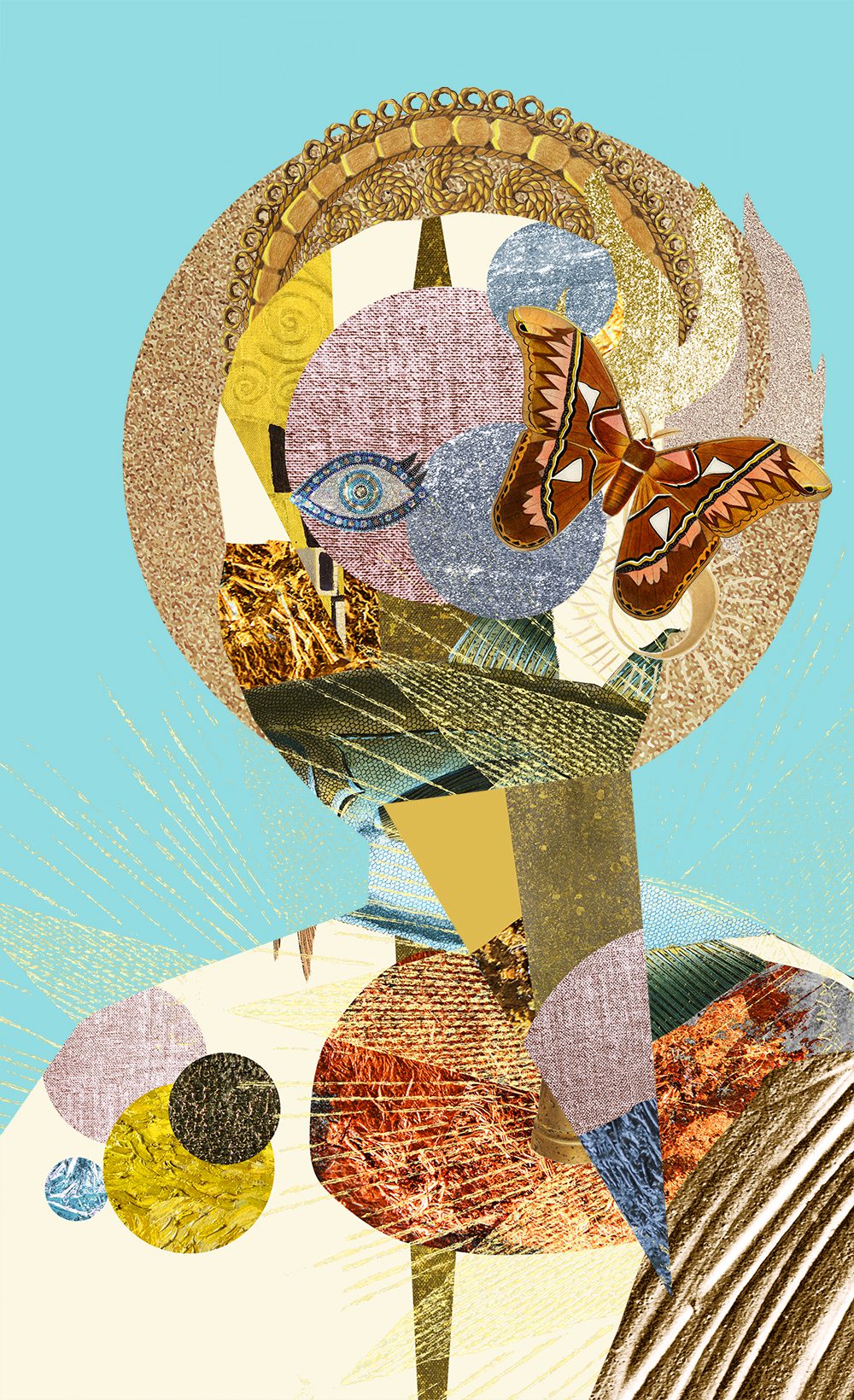Tree Auditor
As part of the larger (Nambour/Namba-based) Keeper Project, Fiona Harding took on a self-assigned, tree auditor role spanning three weeks. The work utilised costume, photography, and data collection to record trees and resident’s attitudes towards them. Over the three weeks, a plethora of data was amassed (including 5242 photos taken). Below is a collection of that data and documentation of the work.
The work was carried out upon Kabi Kabi/Gubbi Gubbi country in Nambour/Namba. Respect to elders past, present, and, future for their invaluable custodianship and connection to land – it’s a privilege to work and live here.
‘Tree Auditor’ was developed for The Keeper Project (Nambour/Namba), produced by Red Chair and developed in collaboration with Field Theory in partnership with Sunshine Coast Council.
INITIAL DEVELOPMENT
/before The Keeper Project (originally piloted in Coolum) came to Nambour/Namba, Andrew from Red Chair (the producers of The Keeper) had undertaken a Project 24 residency (May 2023) to see the viability of the Keeper within Nambour. Andrew had meet with a few artists in the area, including myself, and discussed the framework. During that time, and in conversation with Andrew, I unraveled the theme of trees as my core connection to place and what drew me to move away from the city to Nambour/Namba in 2008.
FEB 2024
Submitted an EOI for the Keeper project in Dec 2023 and on 22-02-24 was notified of my application success.
MARCH 2024
(15-17th) ‘The Assignment’, a three-day development intensive run by the Melbourne collective Field Theory (facilitated by Martyn and Jason). Across the three days, the 11 Keepers shared stories, spent time in the streets, were shown examples of social artworks, and were given an overview of social art and the various ethics involved. Key takeaways included making the invisible visible, picking one thing to amplify, setting up a situation (through set rules and repeated actions) and using what you already use in your practice – for myself it was; costume, photography, repetition, and nature. At the end of the three days, we shared our potential ideas. I had several concepts but the one I had been developing (since my chat with Andrew) was to wear hi-vis and be an ‘official tree recorder’. Jason told me “you need to do a tree audit” and to gather as much info as possible that if I followed my interest in trees it would lead somewhere great – tree Auditor was born.
MARCH – JUNE 2024
I had roughly three months after the assignment to develop my project. I compiled an extensive Google doc, listing my rules and repeated actions, project summary, costume sketch, forms, walking routes, and equipment checklist. I designed a tree audit form for my field recording, based on auditing information I found online. I created a paper and online resident tree survey, alongside a project email address for the public to contact me. I sourced my costume from the op shops and had my thrifted hi-vis vest embroidered locally by Next Level. I spoke with Narelle Sunshine Coast Environment Council who gifted me the book ‘Green Legends’ which was a fantastic inspiring read! I chased down tree arborists in my street to ask questions around their processes. I started volunteering with Petrie Creek Catchment Care, a bush regen group (run by Norm). I spent a day in the history section of Nambour’s library to learn about the land pre and post-colonisation and identify any tree-named streets. I touched base with Nambour councillor David Law who put me onto council’s 2018 Street Tree Master plan – a long but invaluable read before beginning my project. Red Chair organised a permit for my project and we had a chat with Uncle Lyndon Davis (29-04-24) who shared a wealth of indigenous knowledge. Finally, a check-in zoom with Martyn and Jason and Red Chair (Andrew, Angie and Toni) on (09-05-24). The meeting was informative with Jason encouraging me to let people in and okay to be vague. Shout out to Mieke who helped me put up the tree survey posters (printed locally) around town before my project begun.
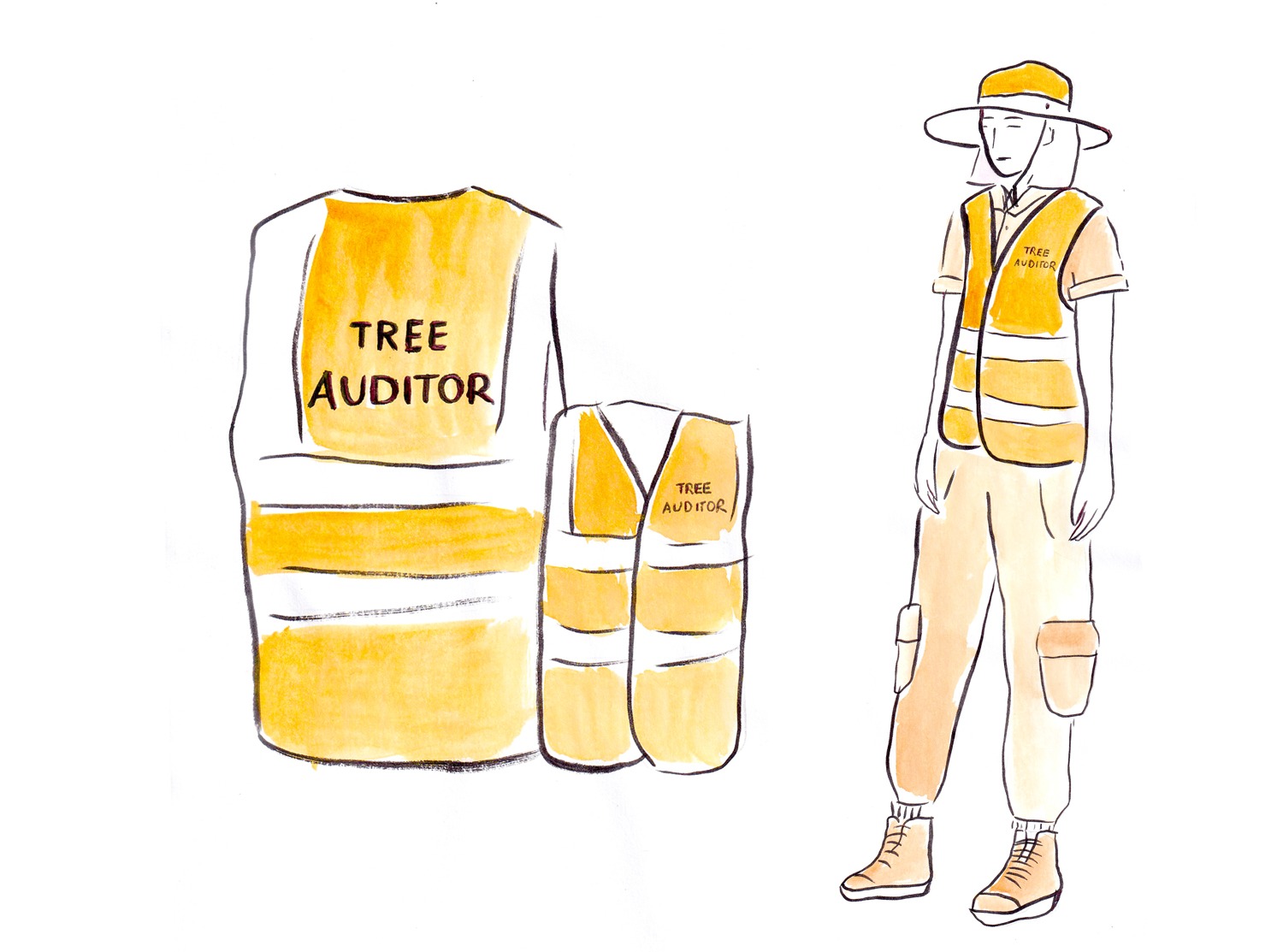
tree auditor costume sketch
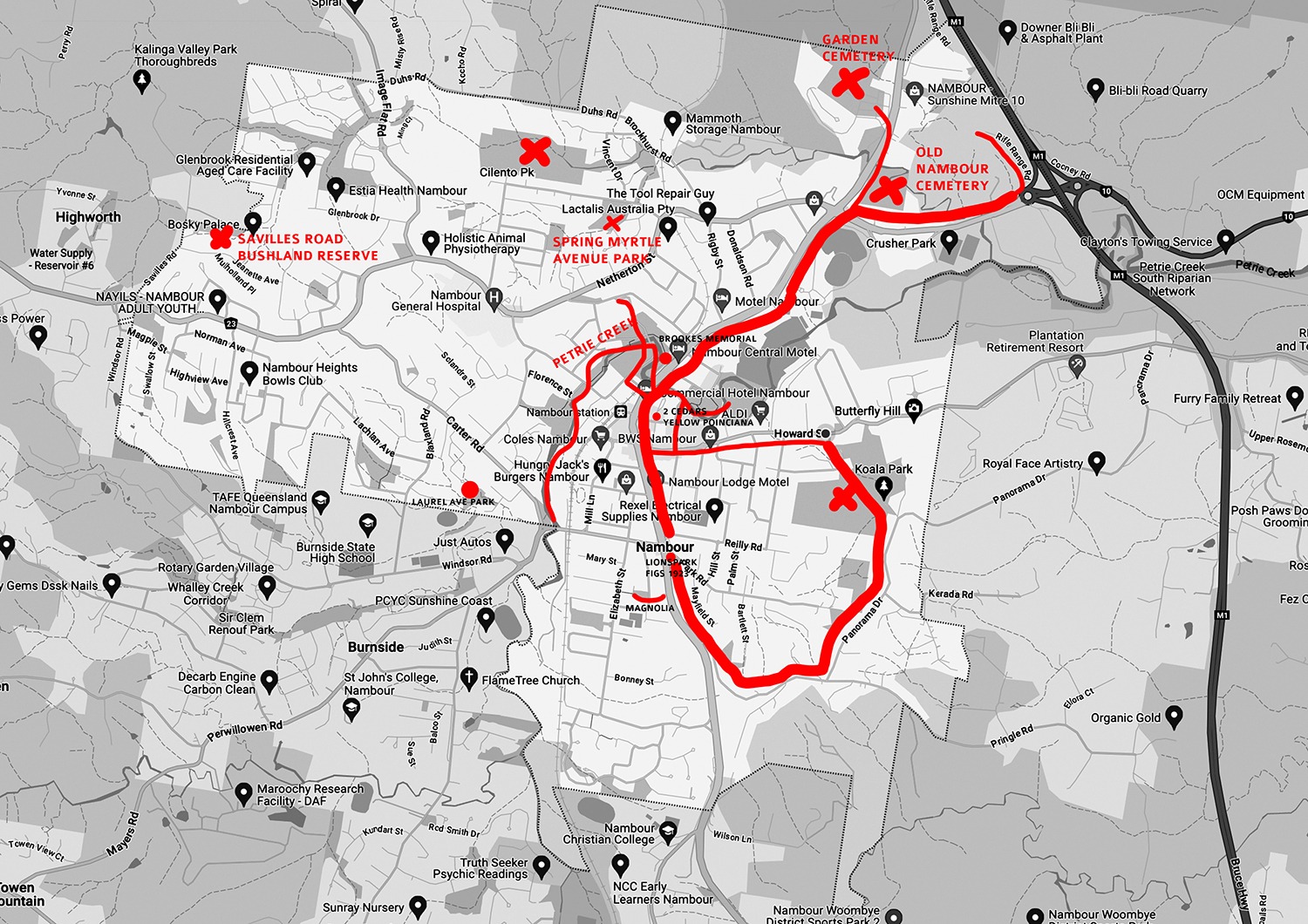
proposed walking route
THREE WEEK PROJECT
DAY ONE – MONDAY 24 JUNE 2024
Started the project at The Old Cemetery, a quiet spot to find my footing, to run through (for the first time) the process of auditing trees away from the eyes of the public. The actual auditing I discovered was far slower than anticipated. I only managed to audit a tiny corner of the Cemetery.
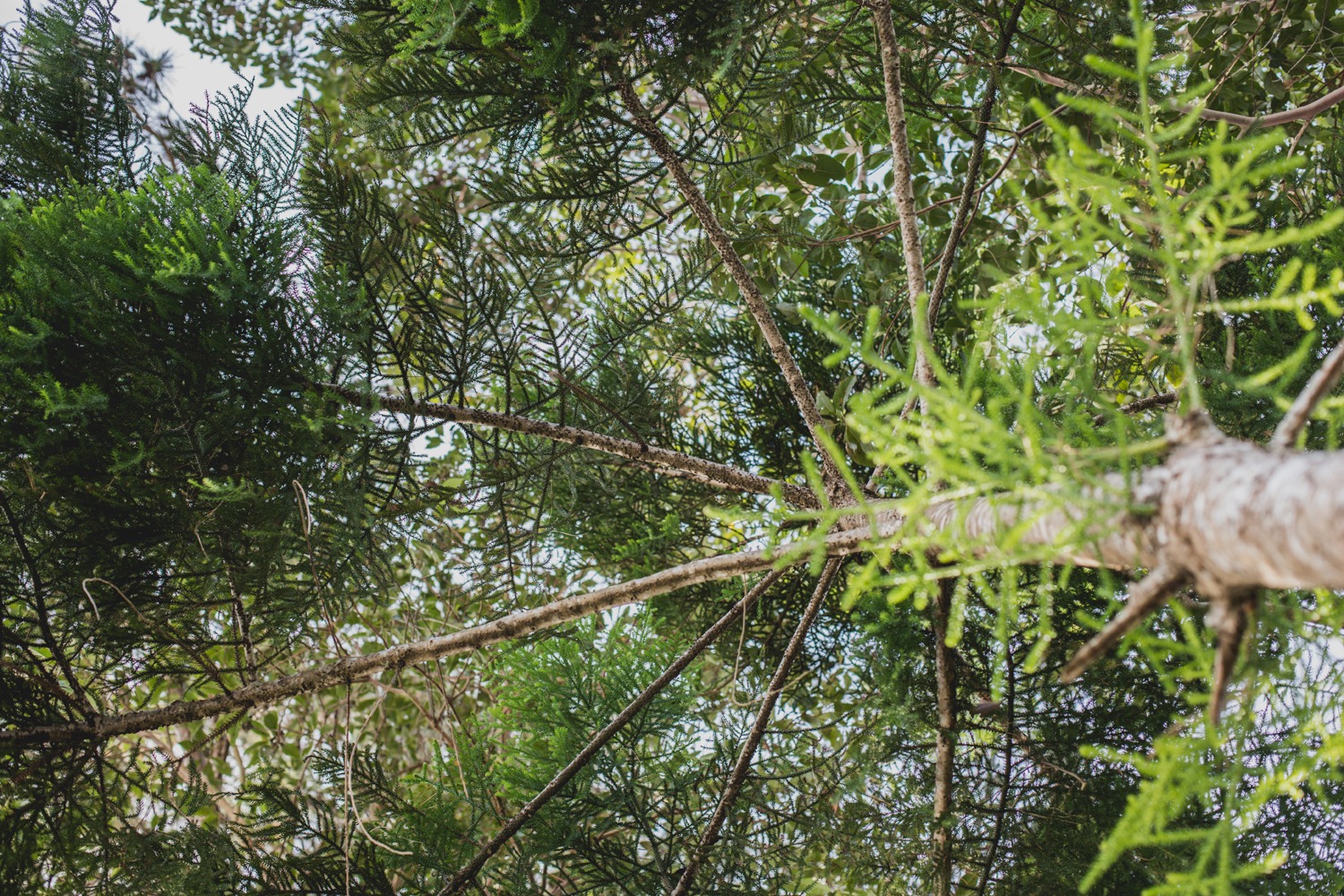
looking up at a conifer
DAY TWO – TUESDAY 25 JUNE 2024
Ventured down Coronation Ave and finished at Brooke’s Memorial Park. Today would highlight one of the reoccurring trends of the project – older white males approaching me (sometimes aggressively) to give their opinion. Found out from Paul that he hates the Cocos palms running down the middle of Coronation Ave because they harbour pests/cockroaches. Discovered new tree plantings along Donalson and Rigby St, apparently (according to one local) planted within the last three weeks.
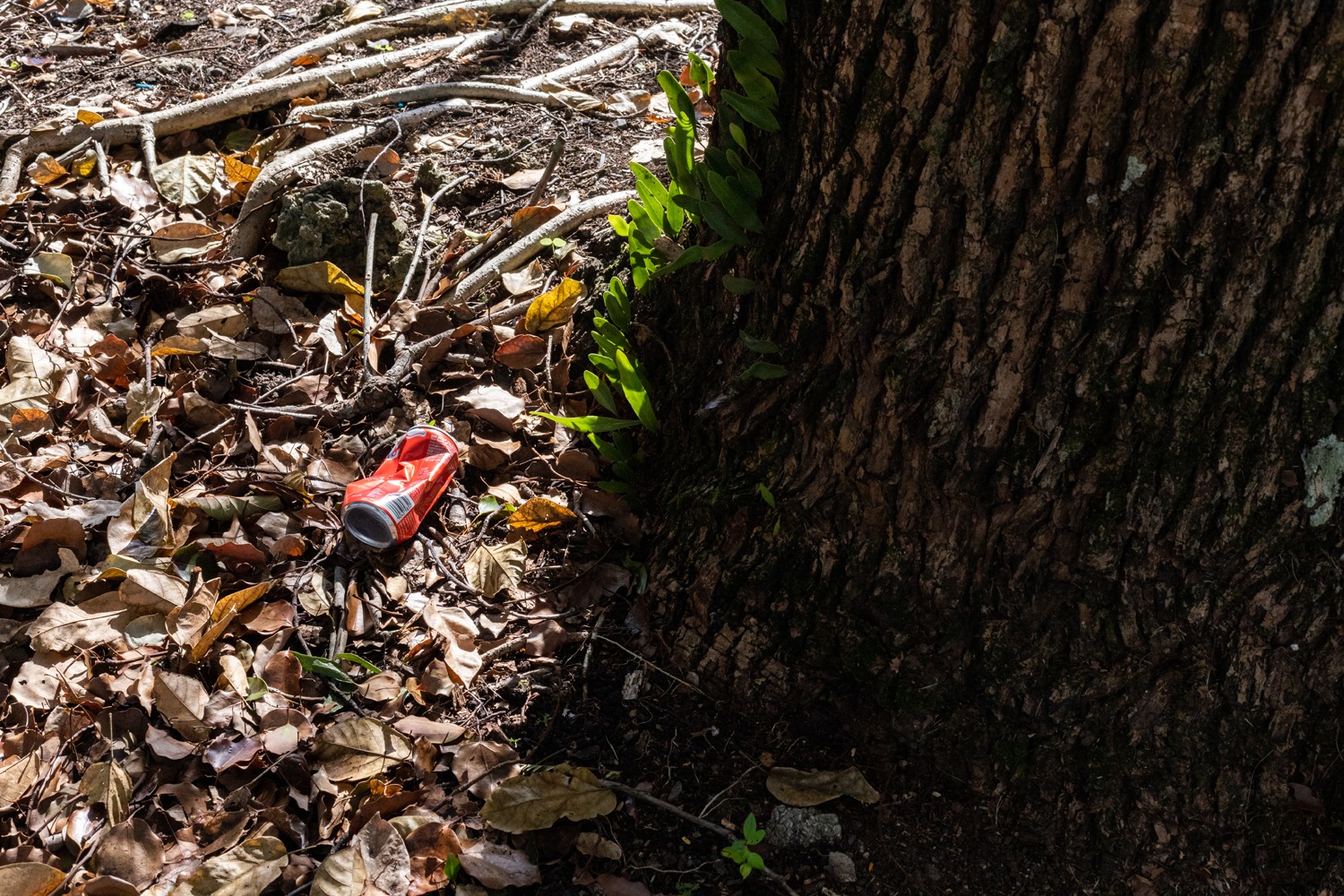
Nambour Still life
DAY THREE – WEDNESDAY 26 JUNE 2024
Explored Petrie Creek and Cilento Park. I started the day off volunteering with the Petrie Creek Catchment Care Group at their Gulung Gung site (A section of Petrie Creek behind the dog agility park). The group’s action bees, which occur in three separate locations, are spaced out over a month and focus on removing weed species and revegetating the environment with natives. I had perhaps my favourite chat of the project with a volunteer named Hein. We talked about a spiritual perspective over a physical perspective and people never seeing themselves as the problem and of humanity’s need to have neat solutions and categorisations. I finished the day in Cilento Park where I met Rob who introduced me to many technical terms regarding the overall environment of the park (housing Tucker’s creek and Robinson’s Waterfall). He mentioned how recently developed land further up in Image Flat meant now, when a large rainfall events occur, there isn’t land left to absorb the rainfall and instead, it floods heavily, all at once through the creek which causes irreversible damage to the trees. I chatted with Rob for over an hour and was grateful for his bigger perspectives and a balanced viewpoint. Usually, trees aren’t found in isolation but part of a bigger ecosystem.
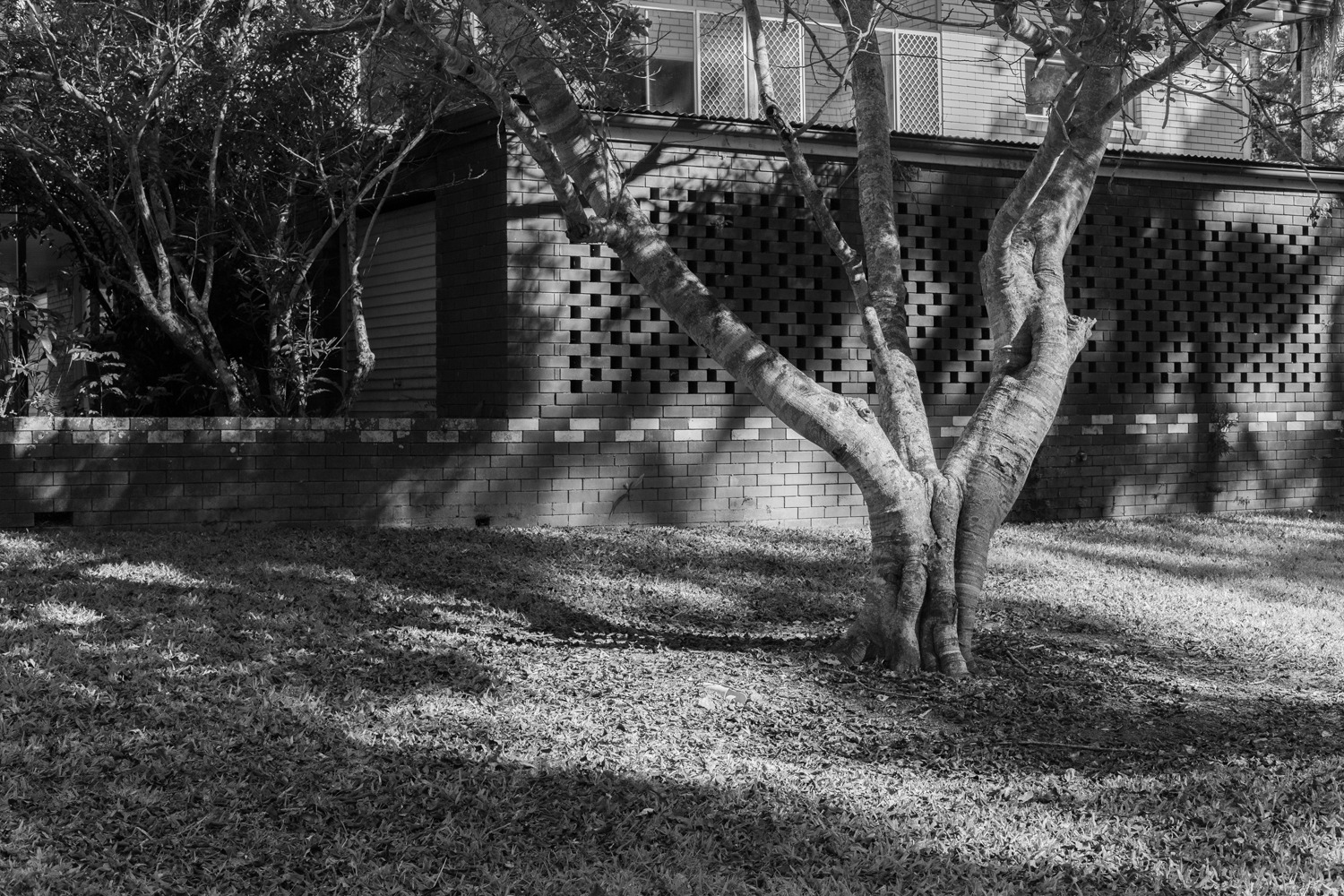
Tree in Cilento Park
DAY FOUR – THURSDAY 27 JUNE 2024
Did a small section of Tuckers Creek (off Vincent drive), checked out Saville Road Reserve, and finished the day at Namba creek at the model railway park. Nobody chatted to me today. One lady stood across the road, starring at me, whilst her dog barked at me, I waved, she waved back. One of the rules in my project is to not go up to the public but to stop my auditing if the public approaches me.
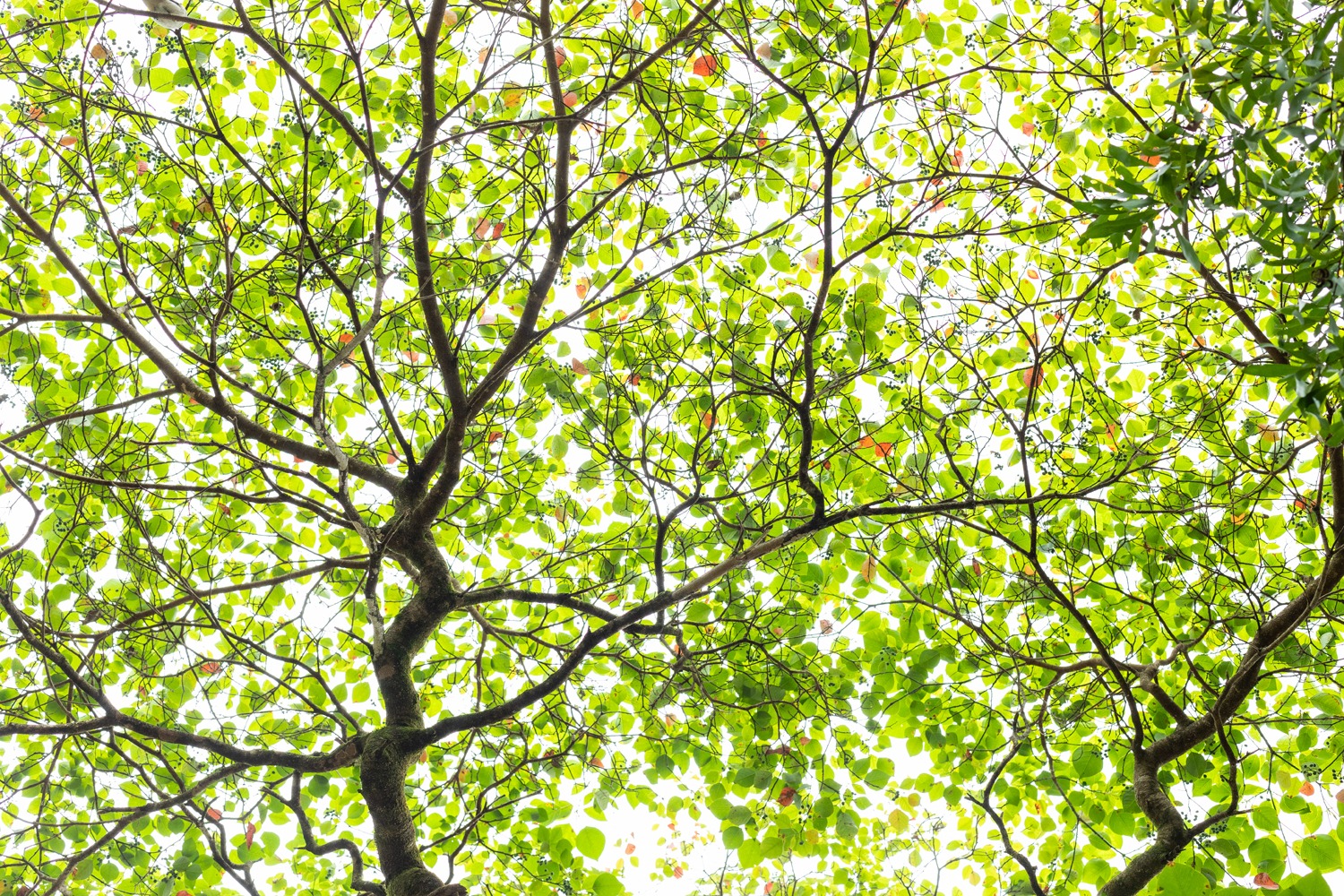
Light through the leaves
DAY FIVE – FRIDAY 28 JUNE 2024
Had my Keeper handover with Shikani (Keeper number 1). Our handover was pushed back because Shikani fell ill on her last week. After the handover, I explored Spring Myrtle Ave Bushland Reserve and the new Dog Agility Park (Price Busters entrance). It was the school holidays for my first two Keeper weeks so I encountered lots of kids but today was the first day they approached me. The kids bought fun energy and we had a great positive chat about trees! In the new dog park I discovered new tree plantings including the red bottle brush (Melaleuca viminalis) and the white flowering bottle brush (Melaleuca salignus). Both bottlebrushes are contenders as the Indigenous name for the town, Namba (potentially Nambur/Nambour).
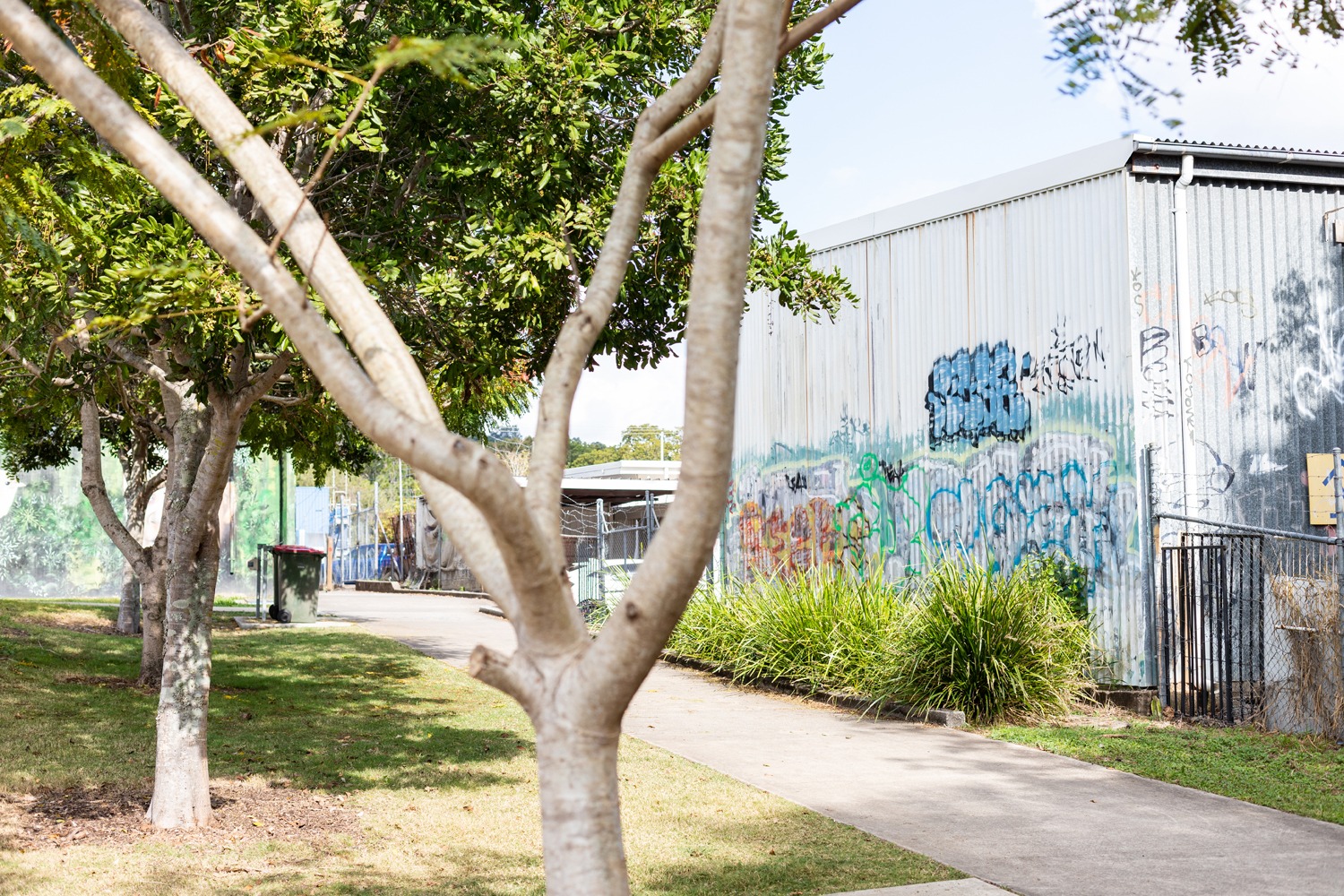
Pathway into the new Dog Agility Park
DAY SIX – MONDAY 01 JULY 2024
Today was a scheduled video shoot with Tim Birch to gather documentation footage for the Keeper Project. We had talked previously about locations and an open field (Petrie Creek Park) seemed like the winner to grab some drone footage. For my interview segment, Tim placed me in between two big pines which I loved because if pressed for a favourite tree I’d probably tell you a pine was my favourite. Unfortunately, after a week of glorious winter sunshine, the wet weather kicked in and we had to call our shoot off early. I stuck the auditing out for a bit longer and then headed back to 2nd space to do my case notes.
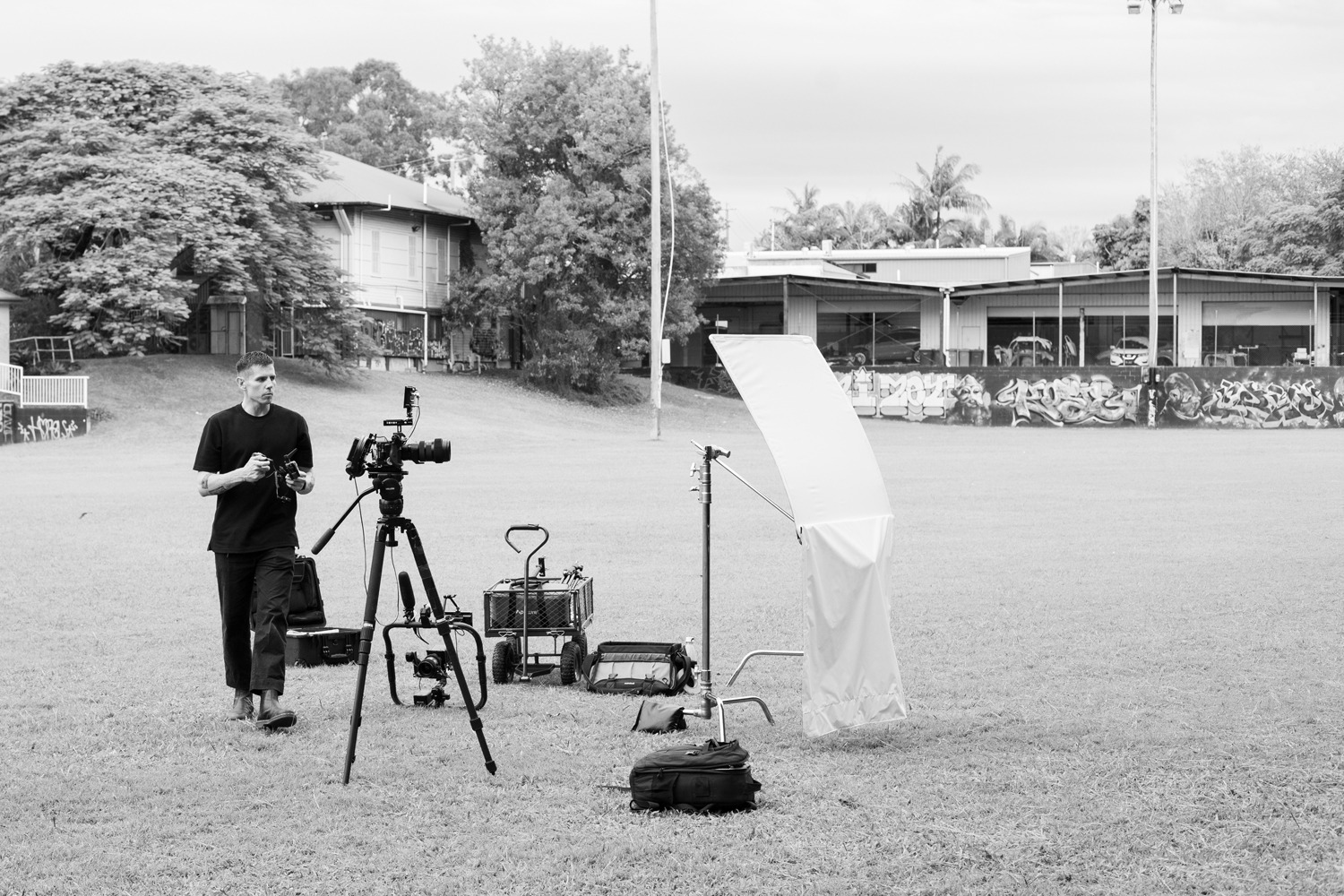
Videographer Timothy Birch
DAY SEVEN – TUESDAY 02 JULY 2024
I had to wait for Aldi to open so I could pick up a poncho and a large umbrella. With the rainy weather set in I decided to explore the lawn/garden cemetery in the morning. The cemetery meant I could have all my gear in my car and park my car super close to the trees. My audit notes, camera gear, and I still managed to get wet and there were periods when it became too heavy, and I had to sit in my car, wishing I had bought a book. In the afternoon I explored Short and Lowe street in town. I decided the shop awnings would provide some protection from the weather and they did. I met a lovely older lady named Elizabeth who said, “I can see you love trees just as much as I do”. During the project, strangers had made many assumptions about me and I wondered if people saw me how they saw themselves, and potentially they also saw trees in relation to themselves.
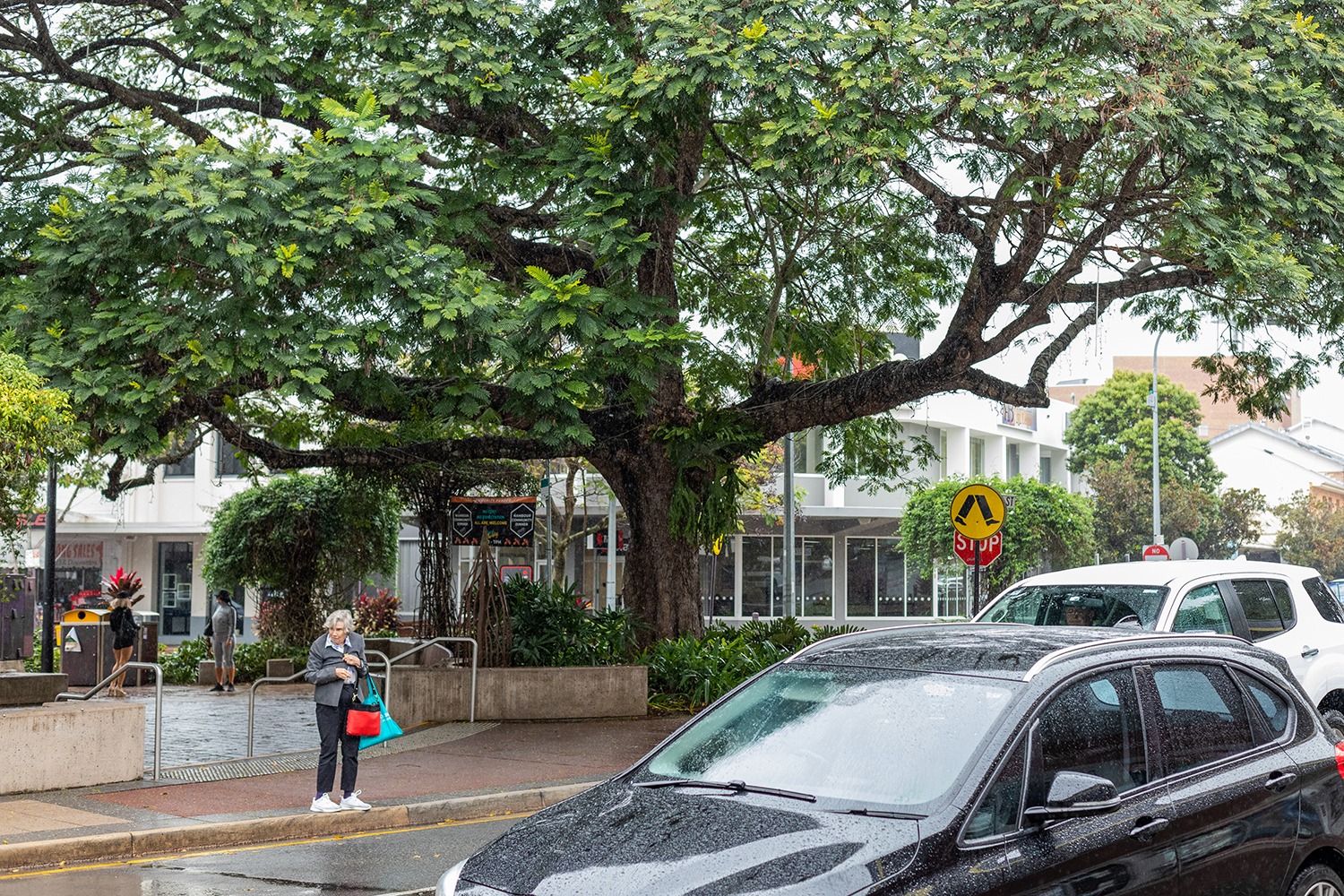
Elizabeth at the corner of Short and Lowe Street – her favourite tree behind, Peltophorum (yellow poinciana)
DAY EIGHT – WEDNESSDAY 03 JULY 2024
More rain, so I returned to the town center, started out at Sydney and Howard St Carpark then walked down Ann and finished on Lowe Street. Discovered the most controversial trees so far, the lemon-scented gums lining the carpark (cnr Sydney and Howard St). The trees house birds and the trees line a carpark and footpath. It became apparent that a chunk of the feedback I was receiving was people viewing trees as being inconvenient. I also saw things I hadn’t seen previously; cigarette butts at the base of trees, chewing gum pressed into tree bark, metal decorative grates around trees, graffiti on trees and magnolias. My poster placed up outside Chemist Warehouse had also received some hilarious feedback 😛
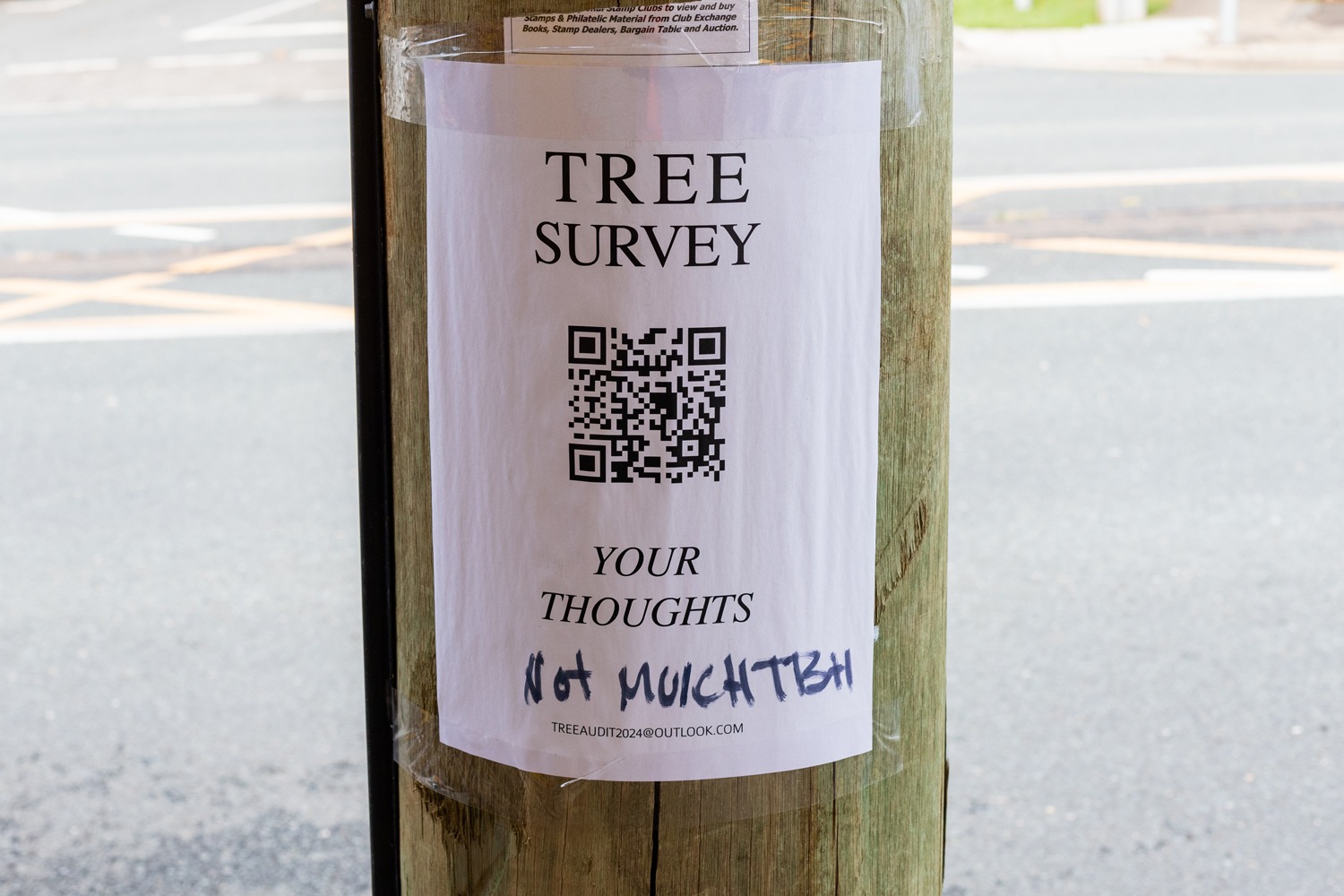
Tree Survey up around town with some hilarious feedback
DAY NINE – THURSDAY 04 JULY 2024
Walked Gary Evans walkway, along Petrie Creek via Florence St and Carter Rd Entrance. In the morning I met with Ardleigh (and her dog Spirit) who shared a wealth of knowledge including showing me an area where a large fig once stood but was uprooted due to changes in the land. Later on in the day I spoke with a couple from outside of the town who were quite confused as to why on the opposite side of the walkway were industry and not a boardwalk. They held concerns of runoff into the water where platypi reside. I was fortunate to spot at least one playtpys during the day which I unfortunately scared off, or more accurately I startled a water dragon who scared the playtpus back into the bank.
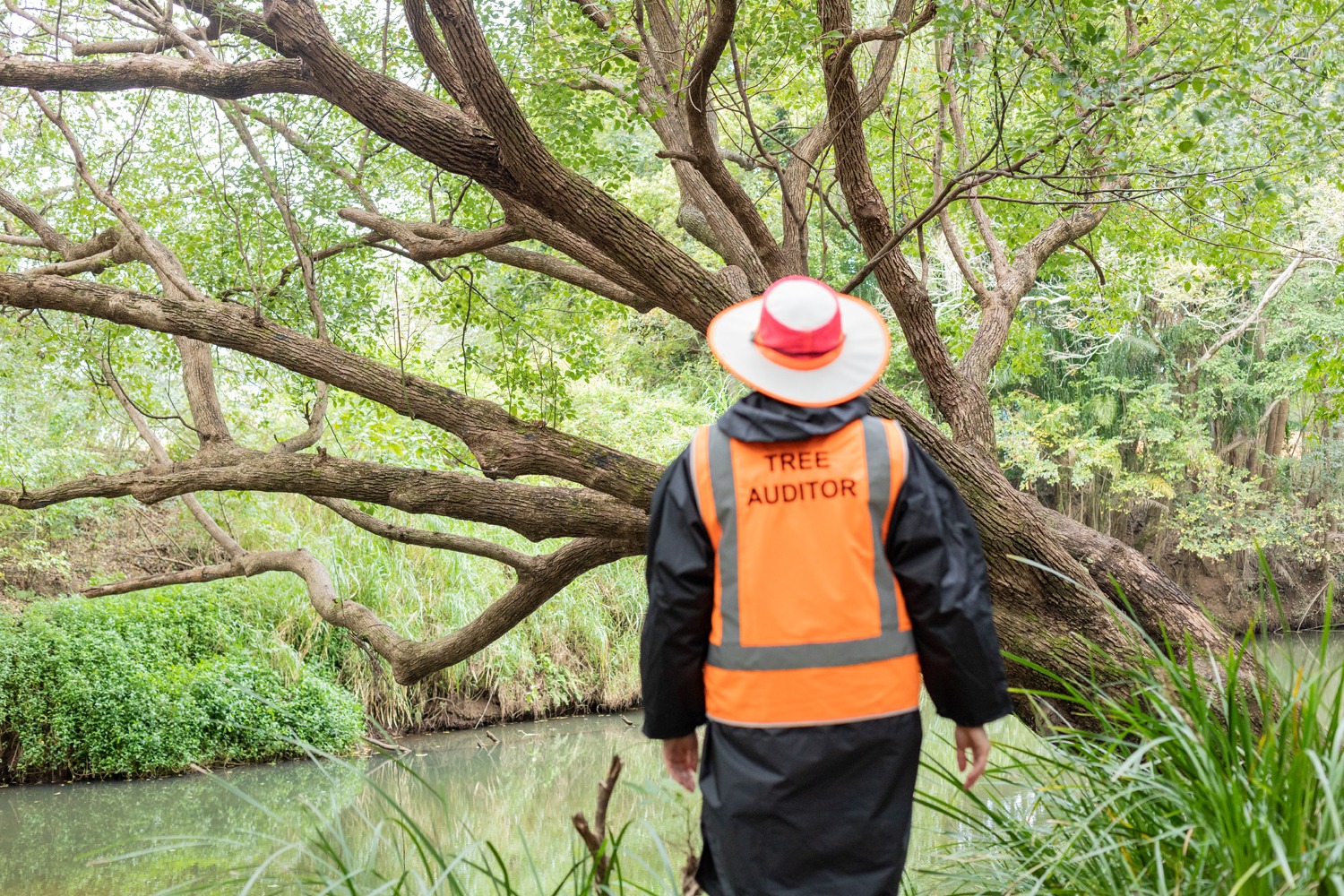
Banks of the Petrie Creek
DAY TEN – FRIDAY 05 JULY 2024
In the morning I chatted with Sarah Howells on ABC local Radio. You can listen to the interview here the timestamp is 1:47:35-1:54:00. My first time on the radio (at least in the capacity of talking about my arts practice) so that was a nerve-filled but fantastic opportunity offered via the Keeper Project. In the afternoon, I audited a section of trees at the corner of Florence St and Hospital Rd. I had quite an aggressive encounter with a middle-aged man, who I speculate was on drugs or at least showing signs of paranoia. I had to be quite deliberate with my words and actions. I had this realisation that those with less power need to comply with forces with more power in order to refrain from being taken out. I had this moment of connection with the trees. I was able to alter myself to protect myself from someone I perceived had more power (more strength) but trees can’t do that. If they don’t comply they are taken out. I sat amongst the trees after this encounter and had a moment of sadness, I wept for those without power and for those in power unable to see what their actions cause.
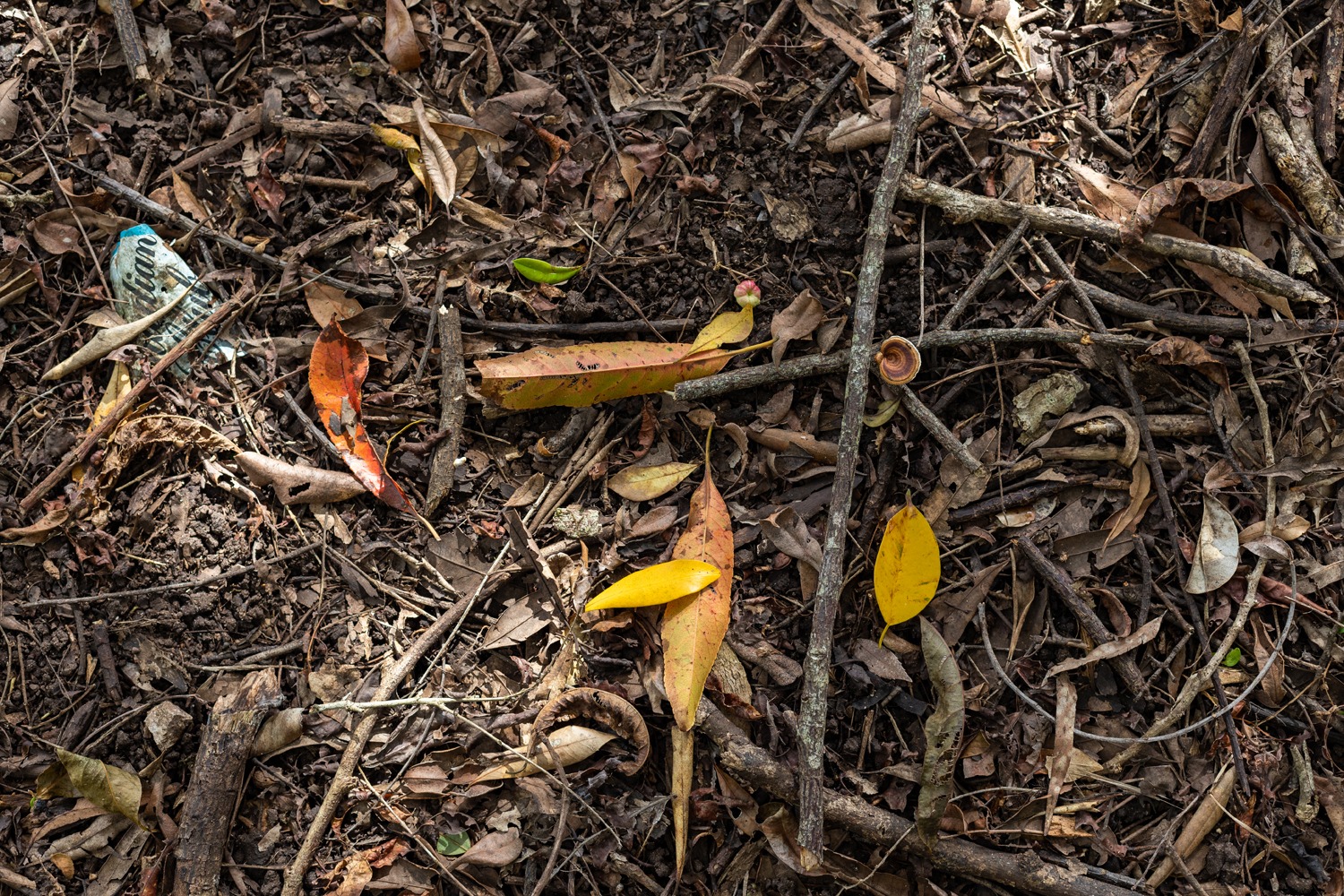
Trees in urban settings, layers of mulch, fungi and rubbish
DAY ELEVEN – MONDAY 08 JULY 2024
I left my favourite place in Nambour/Namba, Koala Park, until the final week. I had assumed prior to starting I would audit around 1000 trees. By the end of week two I had audited 350, so it made sense I’d probably reach the 500. Turns out the rain really slowed things down and by the end of this week I’d finish my audit at 433 trees. I set us base under the covered picnic area at Koala Park and ran back and forth to my gear. It’s much easier to stand in front of a tree with a clipboard and jot down all the info then run back and forth in stages. My metal diameter tape also got rusty from being in the rain, I feared that all the numbers might flake off before I finished the project. I essentially felt like a big old mess! The forest on the other hand was utterly beautiful, filled with mist and glistening leaves. I needed to remind myself that the trees need water and the rain wasn’t an inconvenience to them.
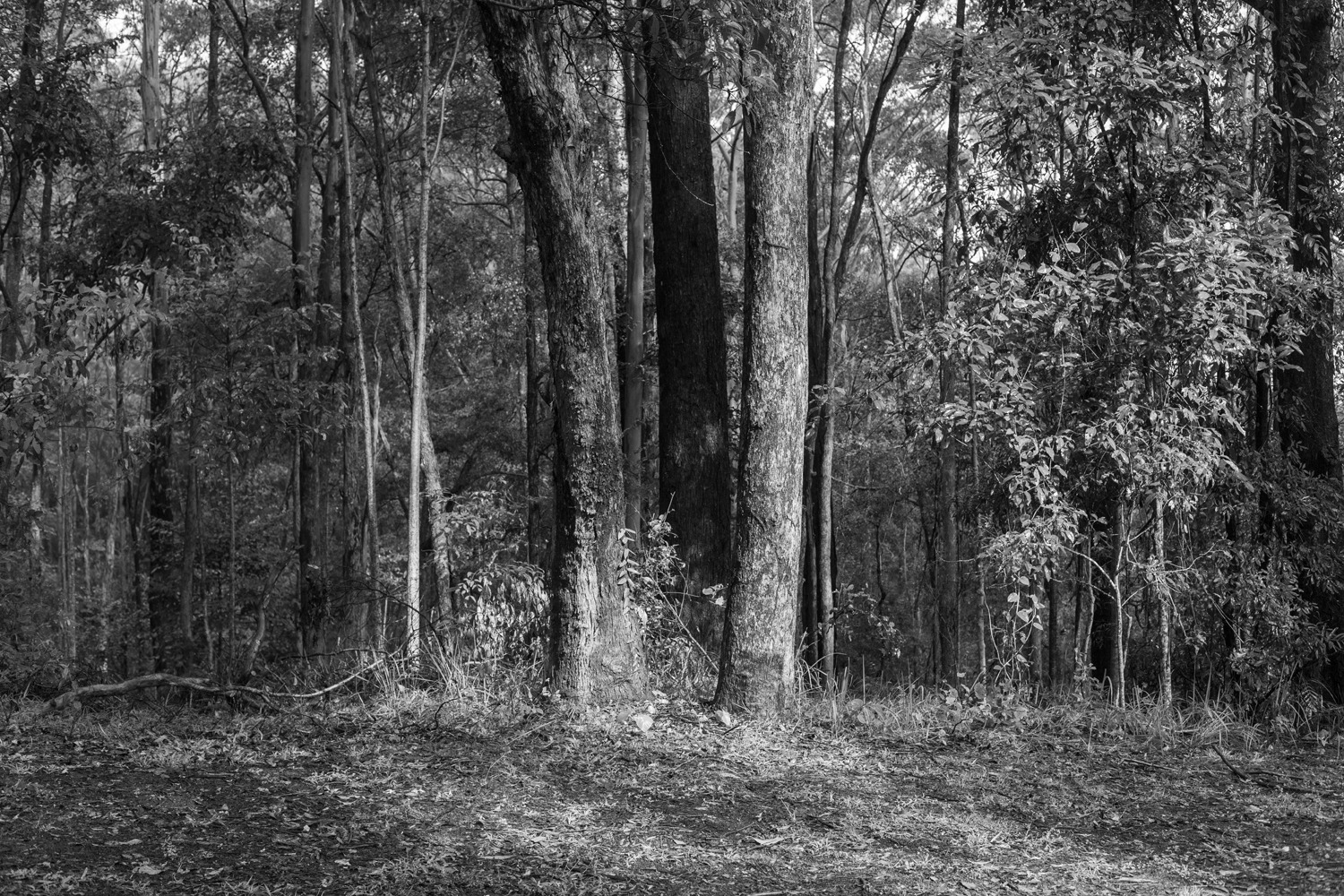
The prettiest light at Koala Park
DAY TWELVE – TUESDAY 09 JULY 2024
I started auditing at the Old Nambour Skate Park, where David Law (a few years back) asked the community to weigh in on the proposal of figs being removed. The majority stayed. They are huge and glorious. I thought I could hide underneath the figs, from the rain, but it simply resulted in larger water drops on my notepaper. Luckily the rain had been on and off so I timed my auditing accordingly, popping everything in the car when it got too heavy. I then traveled to the council-run carpark across the road, which houses the Genealogy Society building at the rear. A lady, Chris, came out to chat with me. She wanted the poincianas trimmed back over the building and the leopard tree behind either trimmed back or removed because the fine leaves made a matt in the gutters and they had to clean them every 6 months. Ardleigh had mentioned new plantings along Netherton Street so I drove past them to check them out. One of my rules was to avoid suburban streets, to avoid shooting into people’s homes, so I took a few overall photos for reference. I also broke one of my rules (to stay inside boundary lines) to meet up with Adelle and her son Jude to see their favourite tree, behind the Nambour PCYC. I had never been there, a section of Petrie Creek which is utterly magical.
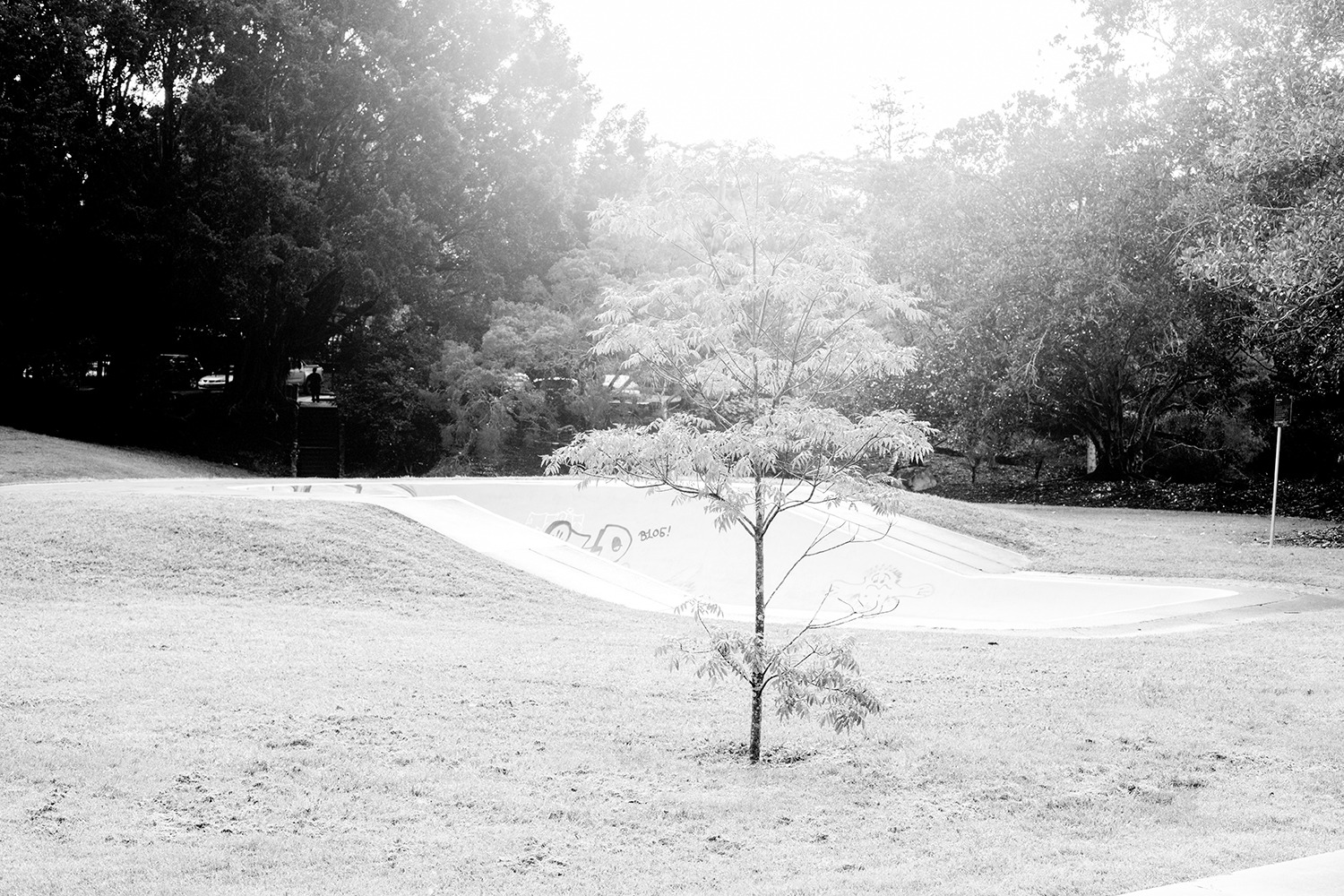
Old Skate Park
DAY THIRTEEN – WEDNESDAY 10 JULY 2024
Although I was still cautiously wearing my poncho, the rain had passed and the final two days would be full of glorious sun! I spent the morning in Quota Park. I encountered a large construction site set up with the install of a wider footbridge linking the old Quota with the new Quota (or dog agility park). I’m not familiar enough with Quota to know if any trees were taken out but it felt stark. Different uses of trees appeared in the park. A tree was being used as a memorial for Aysha Baty, who was killed by a stranger (a man was later arrested and charged) in 2020. There were seats around trees, Kauri pines lining a war memorial, and the most pleasant tree I have stood under, a giant pine near the undercover seating area. In the afternoon I was back in Koala Park and meet up with Stephen and Toni. Stephen has extensive knowledge about tree species and was able to point out tallowwoods, brush boxes, turpentines, and iron barks and share some history. I found it interesting that the few scar trees that remain in Koala park have forked branches and therefore would have not represented as much value to loggers than a single tall straight tree.
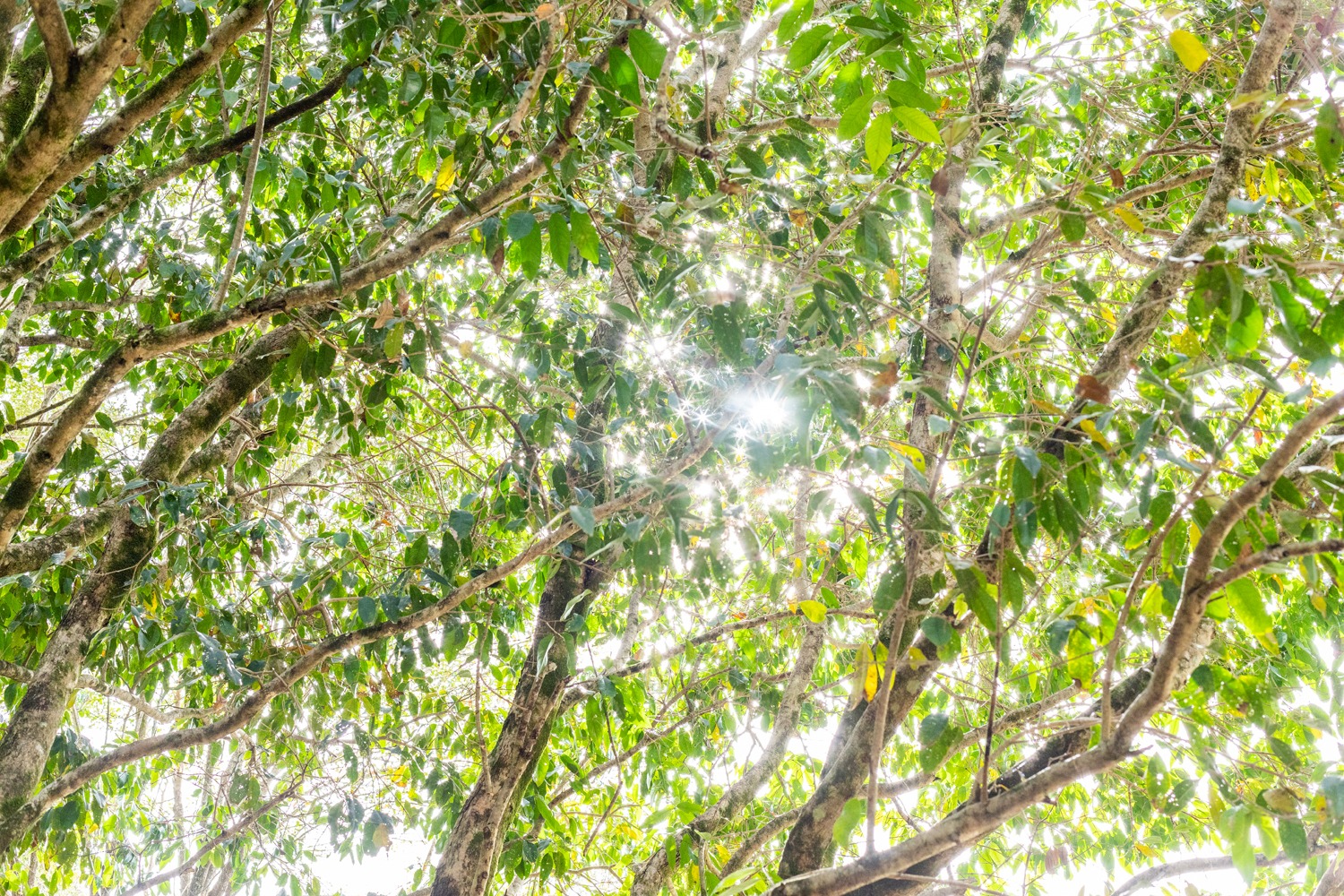
Sparkly light through the leaves
DAY FOURTEEN – THURSDAY 11 JULY 2024
Today I visited Currie Park (cnr of Magnolia and Bundarra st). Before I begun my project I wondered why there were quite a few palms and magnolias in Nambour – they just didn’t seem to fit. I believe the answer to the palms came from council’s Master Tree Street Plan document with palms being “used to provide vertical scale to soften built-up areas”. The answer to the Magnolia trees came from the history section of the library;
“A native of Illinois, USA, Daniel Currie arrived in Queensland from Victoria where he had tried his luck on the goldfields. He selected an area of 640 acres in 1882, Portion 135, which he called Bundara from the Kabi word bin’dha meaning food. He developed a prolific orchard and built a home on what is now known as Magnolia Street. A feature of this street is the magnificent magnolia tree – the Magnolia grandiflora or bull bay. From November to January this evergreen tree with large, dark-green leaves has huge perfumed flowers up to 30 cm in diameter. Seeds for this tree were brought back from the U.S.A. by Daniel Currie’s daughter in the early 1900s. Daniel carefully tended the tree and it is one of the Currie family’s gifts to Nambour. Daniel’s son, Thomas, donated land on Magnolia Street to the Crown (gazetted 1933). This was named Currie Park to honour the family”. Street of Nambour by Barbara Want.
The magnolia is incredible but the mango on the other side is even more impressive. A resident of the street, Ken, came out to talk to me, he said the Mango and the Magnolia were planted around the same time. Ken was upset that I referred to Nambour as Namba and he wanted the frangipanis and crepe myrtles removed because of their winter die back. It was interesting to do this audit in winter. I think it gave me the chance to really view a tree and not be sidetracked by its amazing flowers or even by its leaves. It was fun to think of trees as hibernators, dropping leaves and going dormant to reserve water in the drier months. I wondered if we would have chatted in summer (when the trees were back with flowers) if Ken would have asked me to chop them down?
I finished the day at Lions Park, corner of Currie and Park St. There are six huge figs all (but one) over 1 meter in diameter. Being situated on the busiest road, it was in opposition to my normally calm auditing.
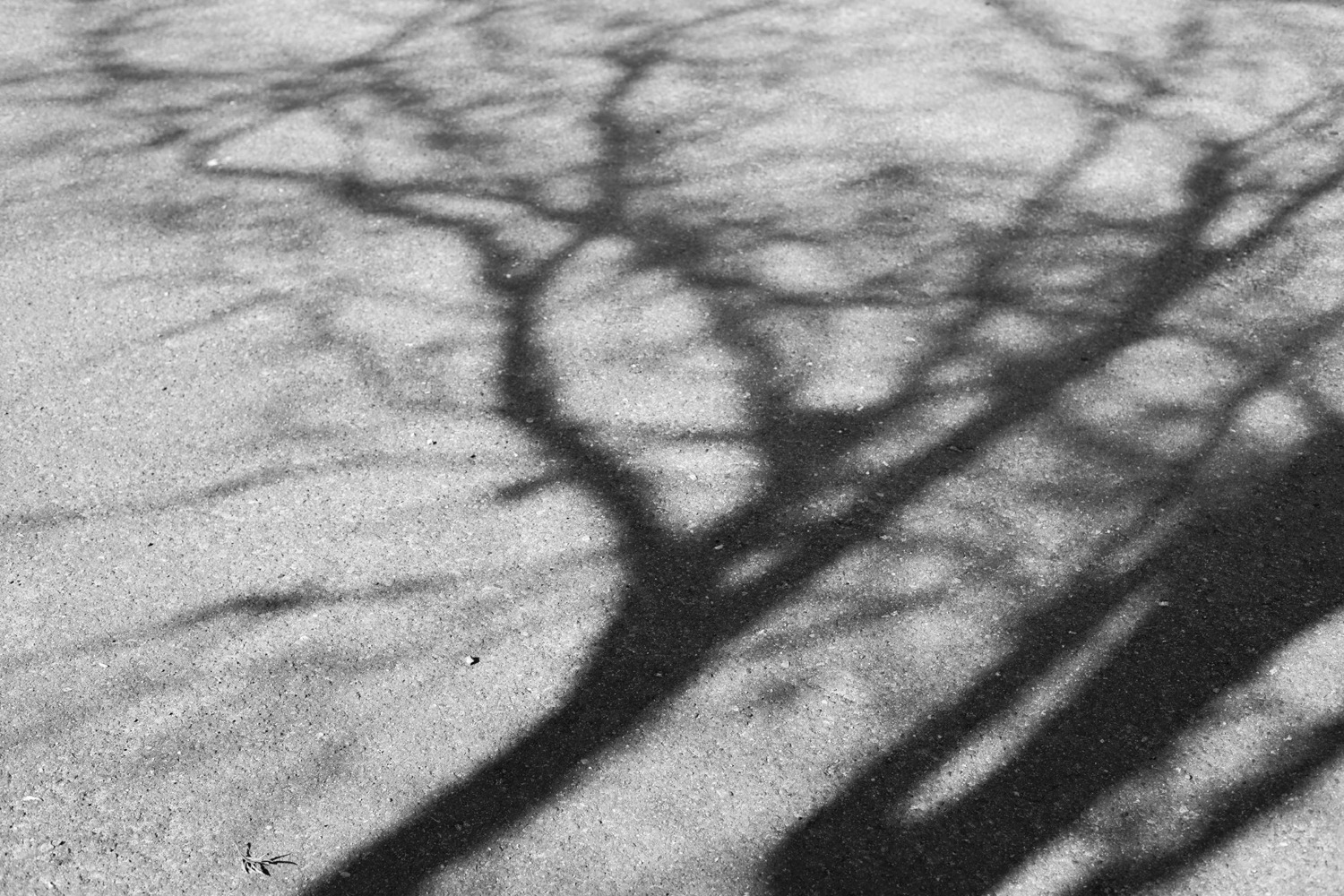
The sun is back, creating beautiful tree shadows
DAY FIFTEEN – FRIDAY 12 JULY 2024
My final day and it was mixed with feelings of sadness and relief. I had grown really fond of forced slow time with trees. I felt this greater acceptance and love for myself and more tolerance for others. I appreciated that trees just are. I saw how humans bring emotions (for good or for bad) into everything and we label (wanting to call something good or bad) and most insidiously we control. I saw trees as wiser beings of the community and the most quiet. I appreciated listening to them. I finished at the park over the road, a photoshoot with Cooper, a handover at the Library with Ant (Keeper No. 2) and a final drive around to single trees people had listed as their favourite in the survey.
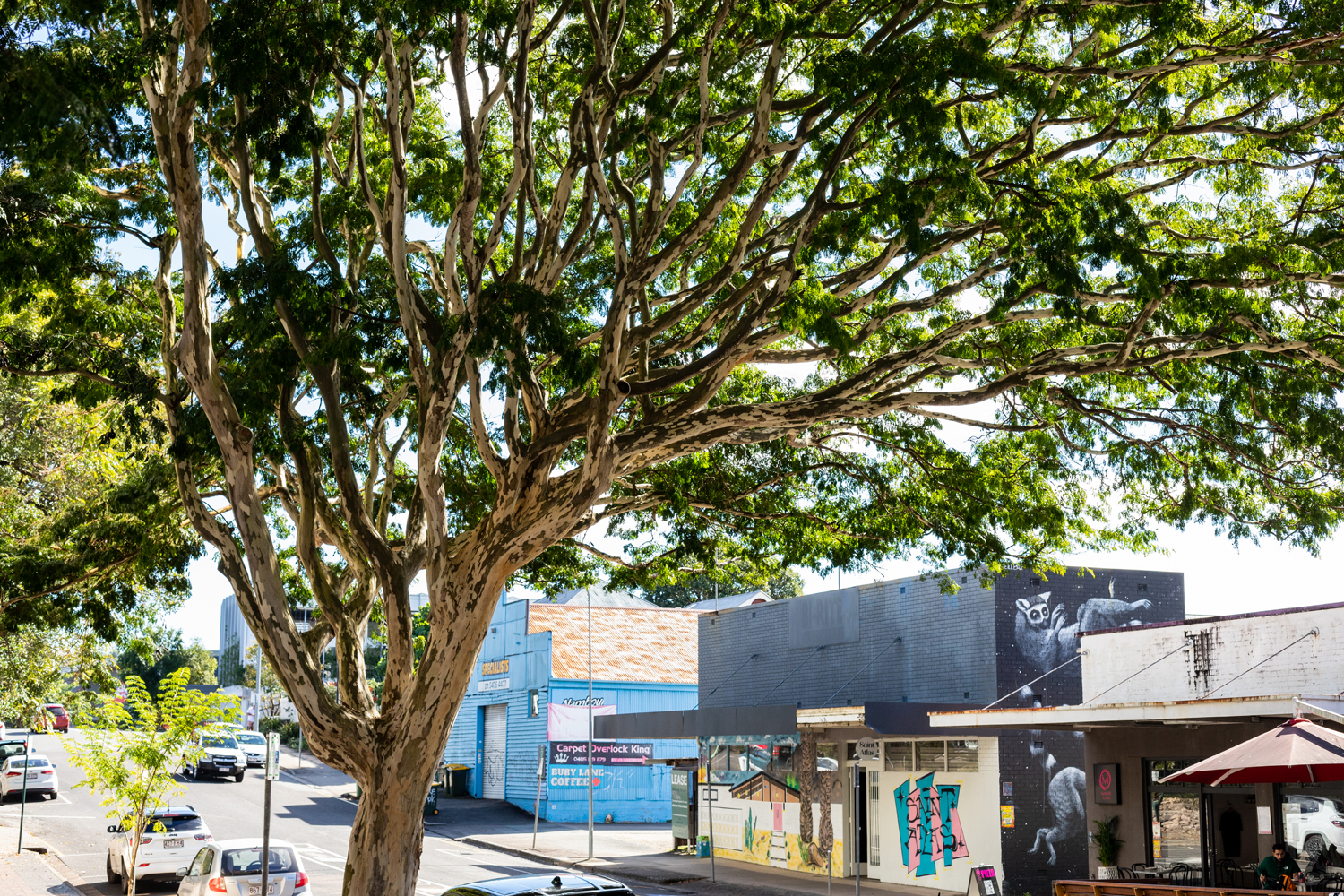
Leopard Tree Outside the Library
STATS
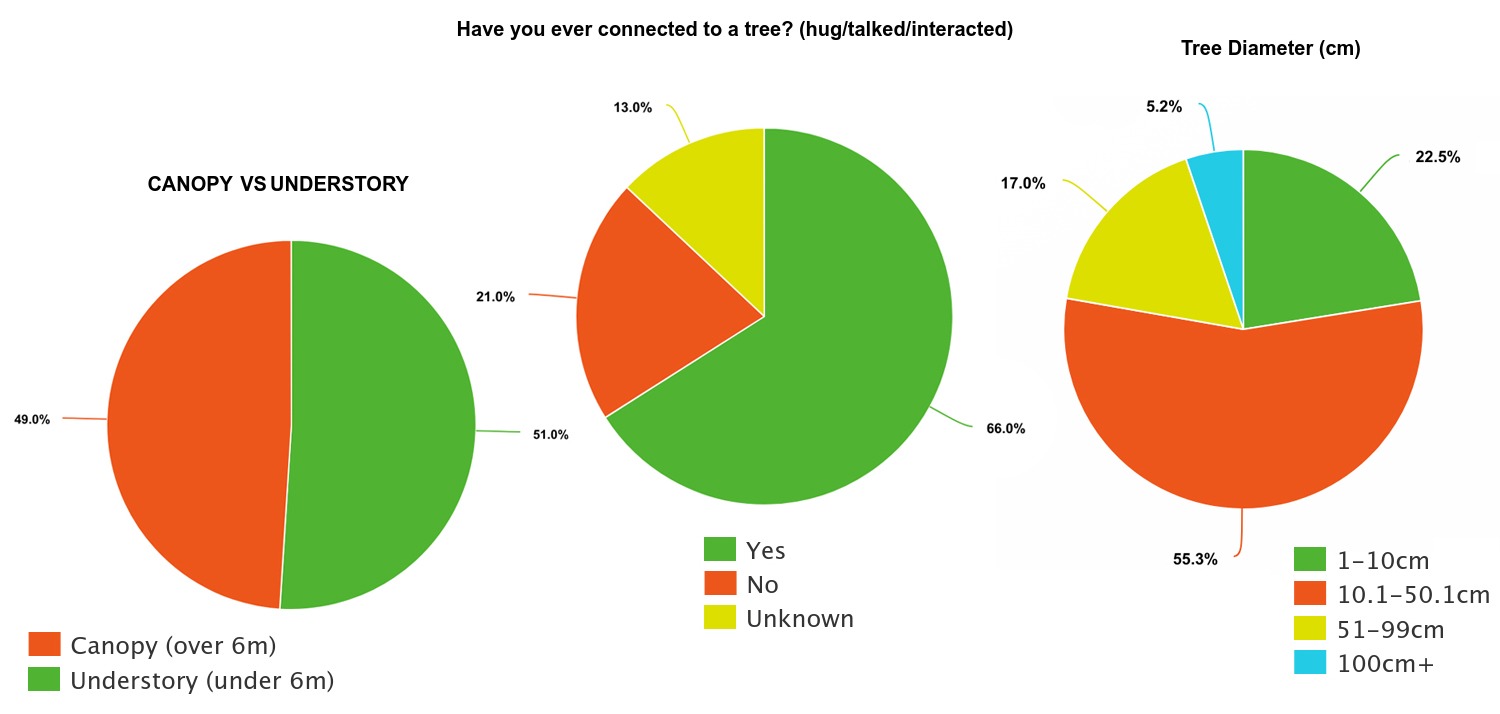
Tree Stats 2024 Nambour/Namba
Over the three week I audited 433 trees. A few interesting stats emerged from the project. An almost even split between canopy and understory trees, demonstrating Nambour/Namba as a place that still has room for large trees. Reflected in The Sunshine Coast Street Tree Master Plan 2018, was the notion that substantial residential development or agriculture was occurring in areas with low foliage cover. Nambour still maintains large suburban blocks with large trees and has allocated pockets of nature. Most trees however were below 50cm in diameter. Not surprising since the first colonisation industry to occur was logging and historical photos (from the start of the century) show an area mostly cleared. The majority of people I connected with during the audit stated they had connected with a tree. I had hesitation in asking the question (receiving some pushback and ridicule) but mostly people wanted to share their stories of connection.
RULES/RITUALS
Repeated Rituals/Actions
1/ Touch/talk to the tree
2) Take photos: bark close up, base, middle, top, full length, single leaf
3/ Fill out audit form: tree no., location (GPS/address) health, diameter, die back percentage, canopy or understory, general observations/notes (species, defects, animal activity, physical description, features)
Rules
1/Must be within Nambour/Namba boundary
2/Tree auditor position is a full-time job with a flexible start time
3/Target main roads and spaces where trees are allowed to congregate
4/Stop auditing if approached by the public and engage, ask them to fill out the survey
5/Only audit trees you can touch and can access without damaging vegetation
6/Start at one location and methodically record all the trees in that area until lunch break or shift ends
7/Case notes (at end of shift) at 2nd space
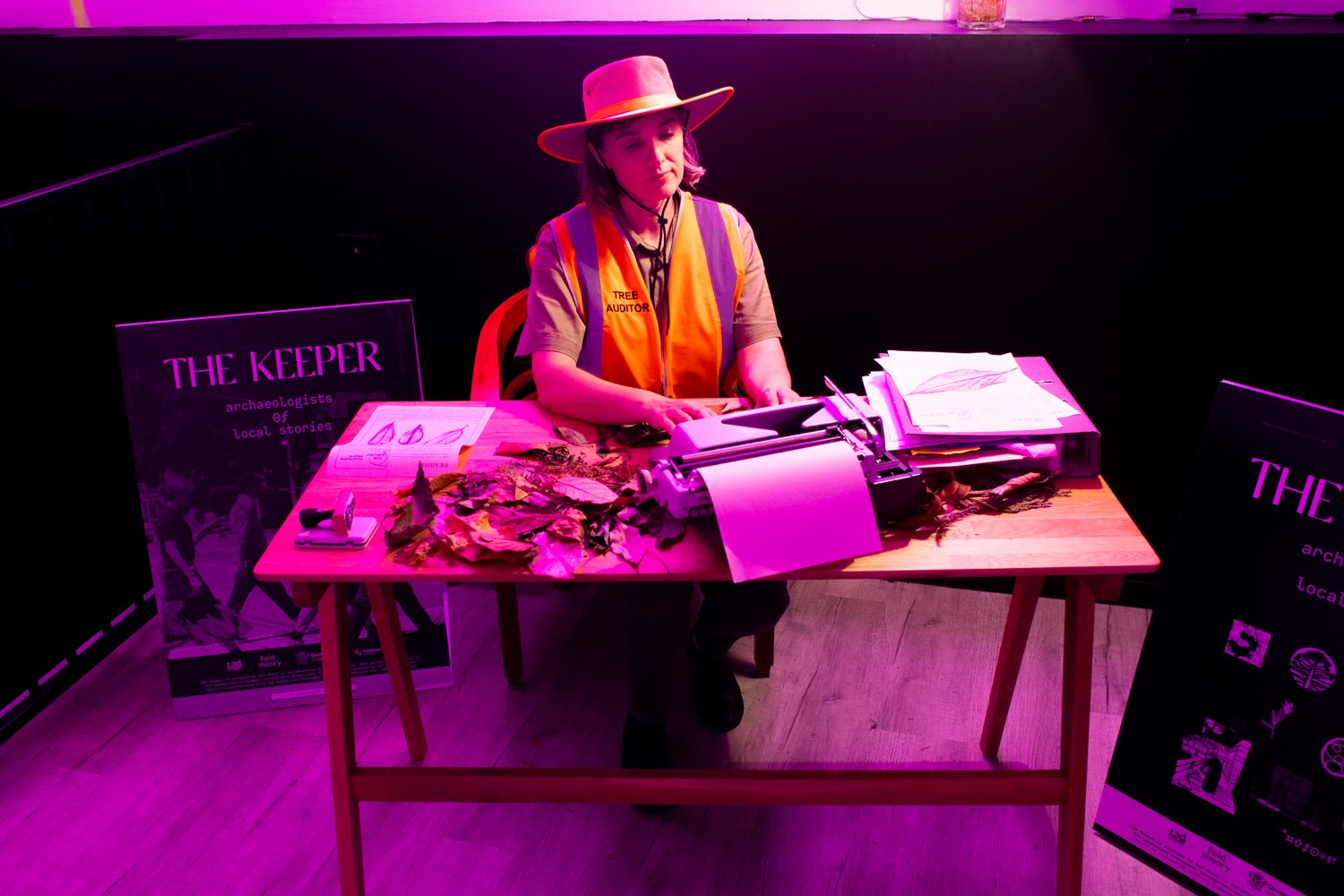
Typing up case notes at 2nd Space
FINAL REFLECTIONS
/A tree that someone wants chopped down can be someone else’s favourite tree; case in point the lemon-scented gums in the carpark on the corner of Sydney and Howard Street
/ Trees work together for the entire ecosystem, they coexist and we to are apart of this larger ecosystem.
/A lot of people want convenience and sometimes trees don’t seem convenient especially if they hold birds who poop, or have leaves that clog gutters, or branches that block views.
/Trees taught me over and over to feel at ease in being you, to own your individualness.
/Even stumps have worth – part of a renewal process
/Okay to go slow, not rush, so much worth in hanging out with trees, the ultimate masters of just being.
/Hi-vis gave me the confidence to stand in the middle of traffic touching a tree, looking up, and just staring. Spending long amounts of time with one tree, its been life-changing – I hope I can continue to make time – I encourage you to try it.
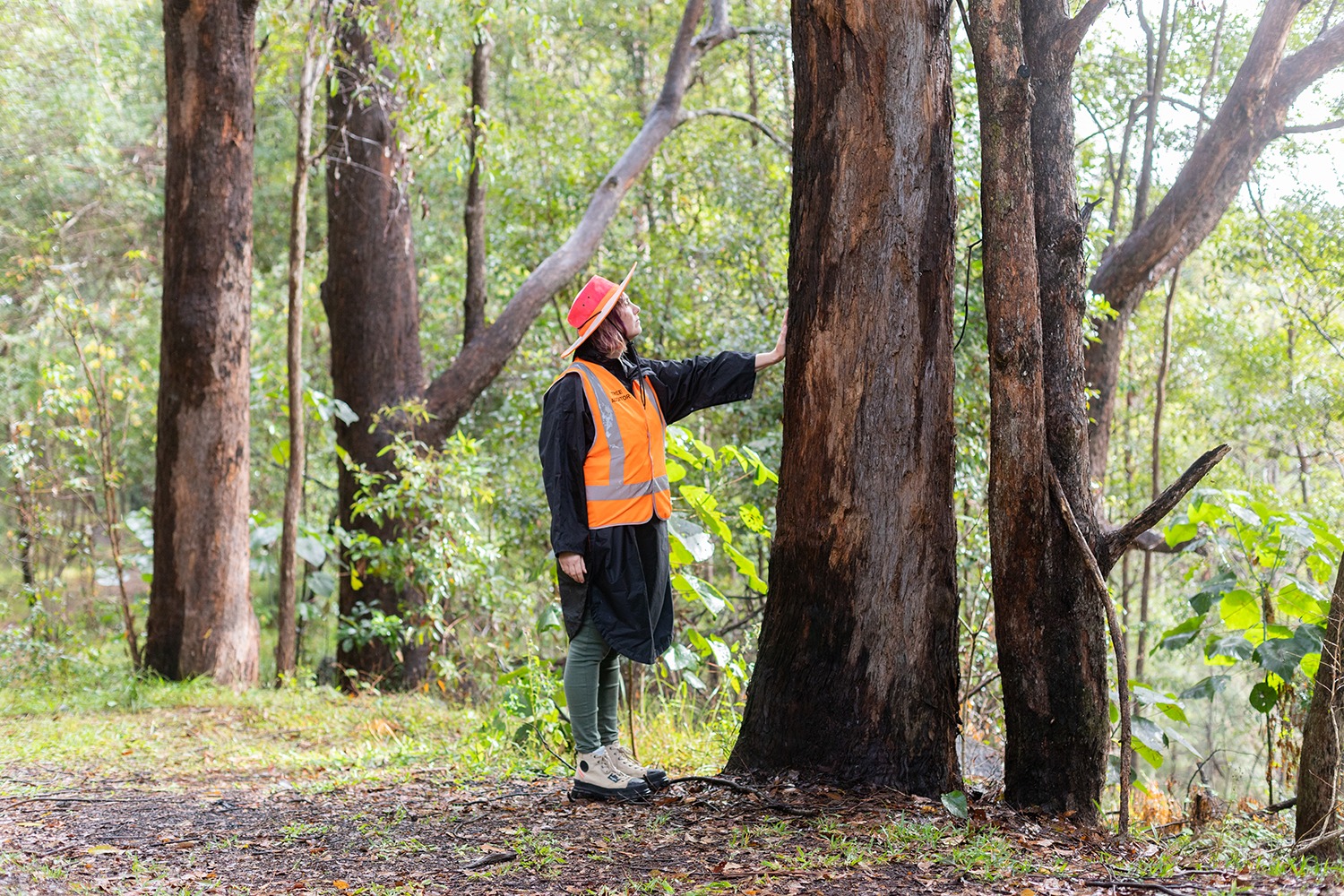
SURVEY QUOTES
note: a sample of the quotes I received via the survey. I tried to represent the differing viewpoints of residents, with the selection of quotes chosen. A huge thank you to everyone (80 in total) who took the time to fill out the survey!
/ I love them and wish there was more – flowering ones. Natives. Big figs. I love to touch the trunks of trees and to sit at the base of them. I also like to hug them.
/Boab tree behind NCP on Howard Street I have tripped LSD next to that tree on a few occasions and been very happy connecting to the boab and it’s ancient energy. The tree is deeply rooted in the Gabbi Gabbi people of the past
/ They’re criminally underrated! We have such beautiful trees in Namba, and some of them are straight out of a storybook. The trees lining the banks of Petrie creek would be absolutely raved about if they were in a more affluent suburb; paths would be beautifully landscaped etc etc
/ALL! COCOS PALMS ARE FILTHY! THAT HARBOUR COCKROACHES PESTS
/I’m not a tree hugger like King Charles
/I pretty much love all trees (even many of the weedy ones). Those big old trees that tower over everything just make my heart happy.
/Native trees with distinctive flowers such as bottlebrush – makes more people interested in native vegetation
/ Too many camphor laurels and other weed trees in the riparian zone
/It is nice to touch them and “feel” their power/strength
/On walks and in parks I talk to and touch trees. Its a meditative and connection experience. I hold my hand on the tree stem close my eyes then look up. I thank them and then run my hands on the textured bark. It calms my heart rate.
/ Spending time amongst trees is good for mental health and general well being. To have this access in a town is truly special
/My biggest concern with the ecosystem/trees is that changes upstream from cilento park has changed the water flow into the creek. Prior to recent development at image flats rainfall events would take 3 weeks to flow through the system, not it takes 3 days. When we get the next dry spell the rainforest in the gully will dry out and possibly burn which will lead to a change in species. If a dune and swale system was funded in the watershed the could be reversed.
/Way too many exotics. Native trees need to be planted to replace them to support the local native animals with food and habitat.
/ Every time I inject a Camphor Laurel or other major wood weed I sing out ‘die you bastard’. When I was younger (up to 7 years) I lived in Toowoomba and spent a lot of time climbing and hiding in the Camphor Laurels surrounding our house. My favourite place to be. Now I spend my life replacing them with natives.
/It’s an ongoing experience …. forests are places of healing for me….walking in forests provides space to process and gain clarity, perspective. Hugging or sitting at the base of a large tree I feel like a child in the lap of a wise elder….it’s very comforting.
/Bird reflectors not working – the white crows ignore them. Council has to do something about it, bird poo everywhere
/ I feel that we should be connected to our trees as they are guardians of our natural world
/From a very early age I have considered trees as beings with which a human could connect and communicate, but this feeling was most keenly illustrated by a psychedelic experience under the influence of DMT. I was with two other people and the lichens and mosses on the trunks of the tree began to fluoresce. I moved away to be alone with the trees and felt compelled to hug a gigantic moreton bay fig. Something I had done many times, but which felt emotionally charged to the point of religious revelation by the hallucinogenic experience.
/They ground me greatly and keep me connected to our natural world.
/I would absolutely love to see more big trees lining the streets of the main town.. particularly along Currie Street. And when people entered our town they couldn’t help but think wow this is so green and beautiful! And maybe some more red bottlebrushes to represent Namba. And fruit trees to feed us all.
/Hugged the tree and felt a wave of energy through myself and the tree
/ I like to thank the trees
/When I see old trees I have a certain respect for them because of their age – hope development doesn’t destroy them
/I’d love to have a walk not industry on the creek bank – factories should not be next to water because of contamination.
/I often talk to trees. The really old ones feel like they hold me. I’m proud of the resilient ones. Mostly I feel like they see me
/ I wish they would remove or the declared pest trees & replace with local natives. Hate the palms centre of Currie street – impedes view while driving.
/I love the magnolias in Howard St and the other plantings around town. It pleases me to see the greenery being introduced.
/ We’re lucky to have so many natives. I love hearing the rainbow lorikeets feeding in the middle of town.
/ I love how they make our public spaces more beautiful, relaxing and cooler in summer. And the patches of bush in parkland and near our house make it a great place to live.
/Hugging the big ones in the hospital park and quota park. Thinking about how long they’ve been there and how they are connected to the earth.
/ I love trees but some have huge branches that fall at any time and the council thinks its ok to leave them one day someone will be killed
/There aren’t really that many. They’re not show stoppers or anything. Pretty boring.
/ Awful, messy, unattractive tree and street planting in general especially the leopard trees and palms on Currie st
/The big fig trees resonate with me. I find myself sitting and touching them for ages
/I wish there were more. It was great to see street trees planted by council recently in some streets.
/One of the towns greatest assets. Especially love the shade they provide and the cooling they bring as well as birds like the cacophony of lorikeets in the evening on the main st
/Hugged many a grand tree and felt a great connection to nature and time. Regularly interact with them by enjoying the shade and cool they bring on a summer day, the protection from rain during a storm and to hear the wind rustling through the leaves.
/Trees always make a town look more pleasant. Except for the tall palm trees, they can look ugly and they’re very messy. Particularly the clump at 99 Carter Road, that’s one good example of bad palm tree maintenance.
/One of the leafiest places that I’ve lived in my life. When you come in from town (trees) they are the most noticeable thing you see
/By talking and acknowledging trees I believe they take on all of our traumas and stresses they help with calming and bringing down our sense of being keep us flat and grounded when we are flying high with emotions and anxieties. I believe the trees are our ancestors and our future we all tying together as one trees, our lungs and our heartbeat.
/I love to stop, look and feel – the bark, the leaves, listen to the wind rustling through, the creaking branches, the birds that inhabit, the bugs that crawl, look into the hollows and crevices, follow the roots. I don’t speak, I just look, listen and feel.
/Trees next to my unit (no idea what they are called) when they flower they an amazing deep pinky red and they look like octopus legs with suction cups. The rainbow lorikeets go mad for these flowers so loud and hypo. Like red frog sugar highs.
/ I love the links our trees give us to nature. They have an intrinsic aesthetic beauty, a softening effect on the landscape, alongside the well documented environmental and health benefits (air quality, water quality, habitat support, mental health)
/I’m a local, a botanist, and an ecologist. I love trees. As an ecologist, I don’t want to see more introduced trees (non-natives) into the landscape. I want to see more trees that make sense of country, and on country – trees that connect our creek lines and bush with native birds and insects. We’ve got sooo many beautiful trees that are local to the area, that have a special meaning to our first nations people and to their song lines, the early white settlers, and to our new song lines. Flame tree, Bunya pine, Hoop pine, Black bean, Moreton Bay fig, flooded gum, silky oak, red cedar, water gum, blue quandong, red flowering tea tree, booyong, white beech, river gum, forest & river oak, grass tree, sandpaper fig, picabeen, cabbage tree palm, Lilly pilly. These (and more) are the iconic species of the region that have made it into new song lines, and connect our country with the oldest songs. Our elders can give you a far deeper and richer list – people like Aunty Bev Hand, Uncle Kerry Jones, and Uncle Lyndon Davis.
/Scar trees in Koala Park Conservation Reserve. They’re a link between conservation, suburbia, and an ancient culture.
/I love them all equally
/ I feel they are in danger because of humans, we want to develop, we want to take away and not add (only) planting trees we want to control. Trees talk to each other. Trees are amazing things.
/The more we build the more trees have to suffer – welcome climate change.
VIDEOS
–
Want to see what else I do? Come peek over on my insta or grab a freebie when you sign up to my newsletter below 🙂 🙂

